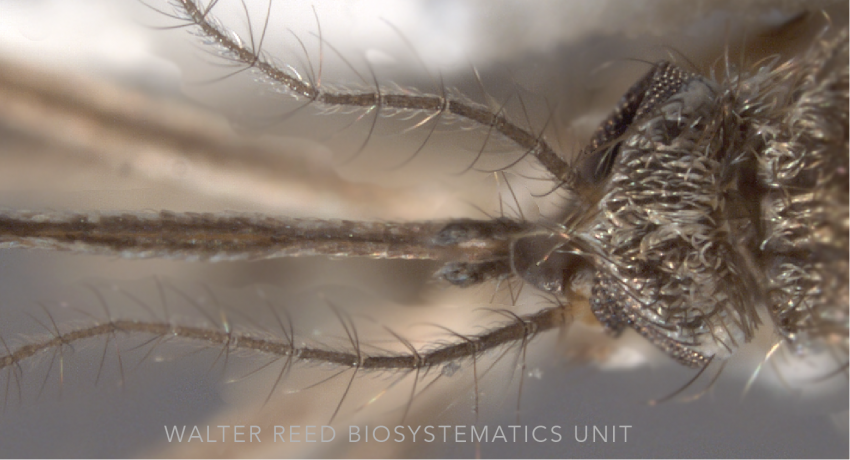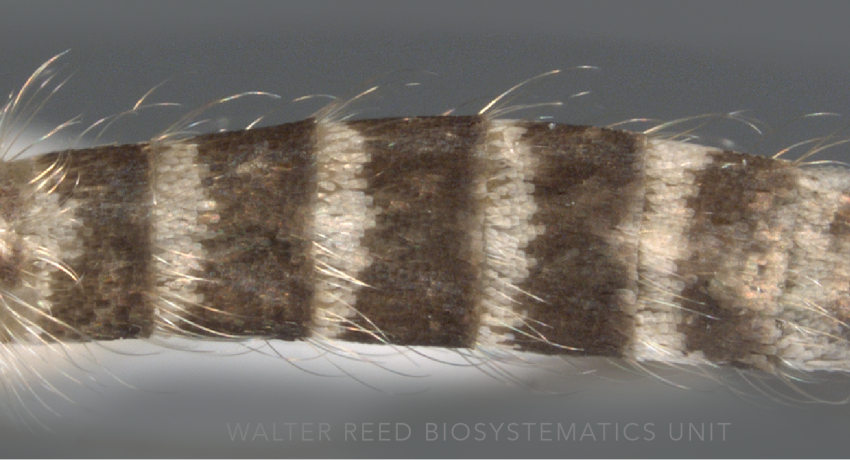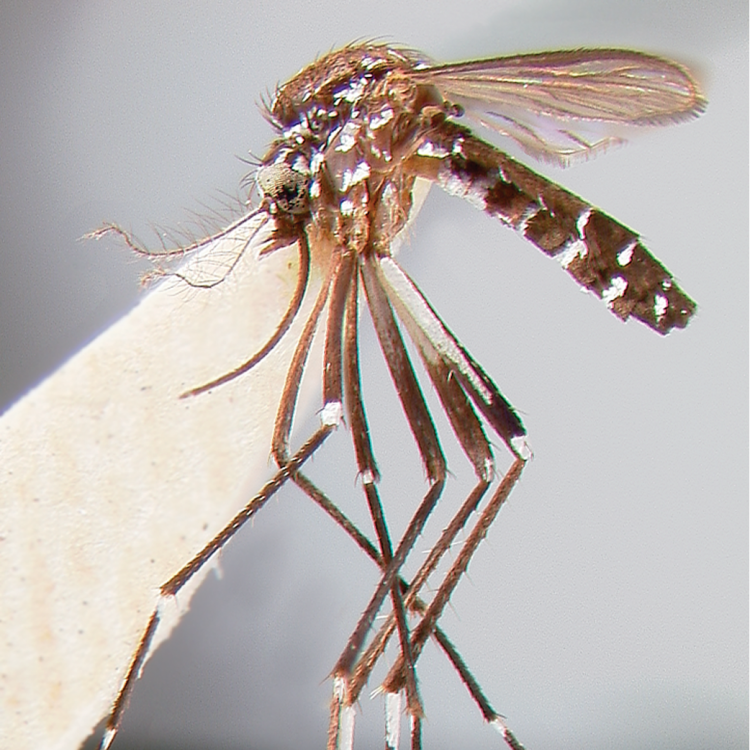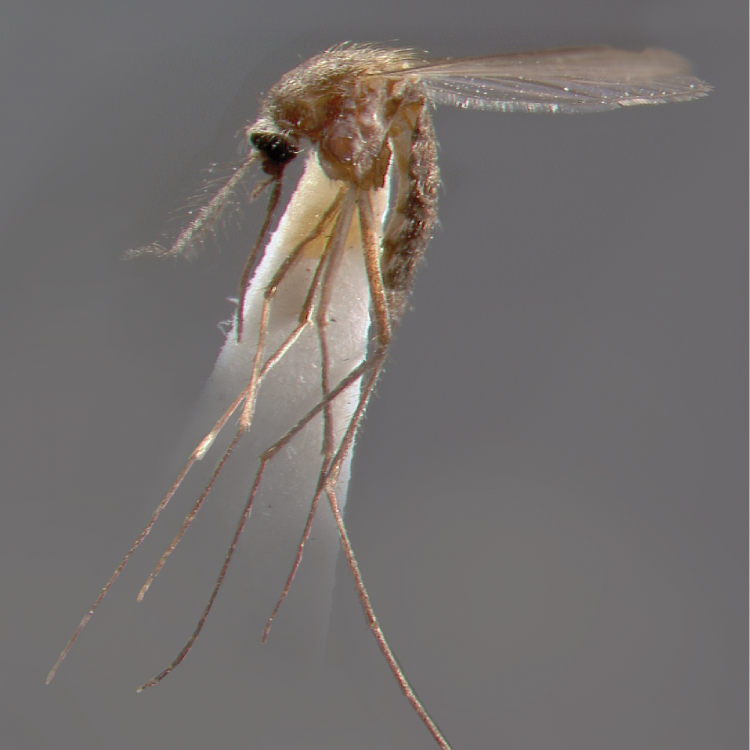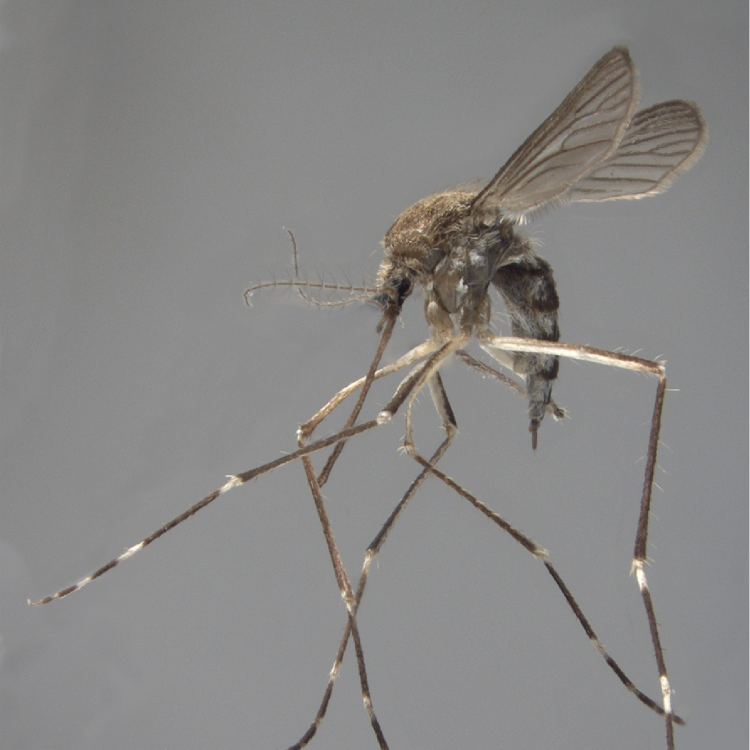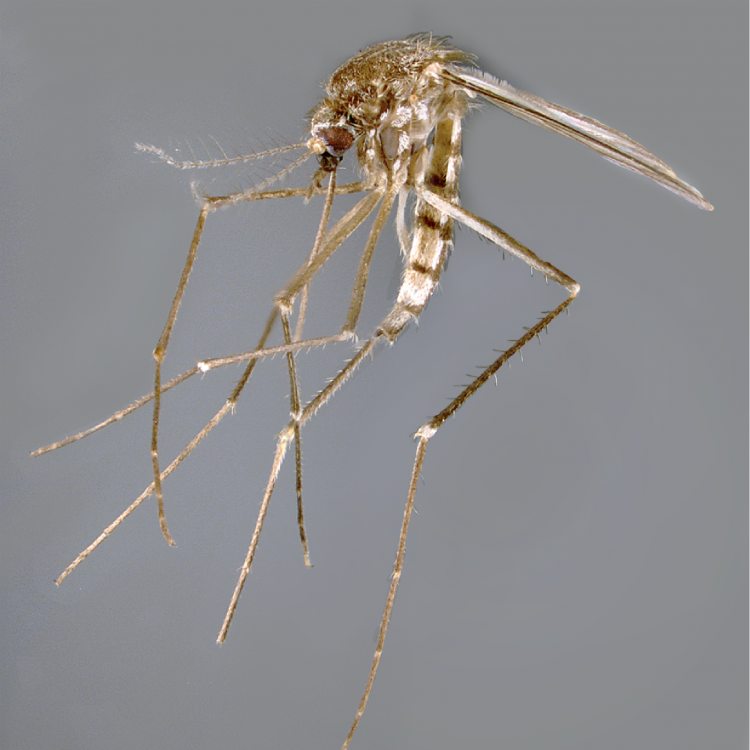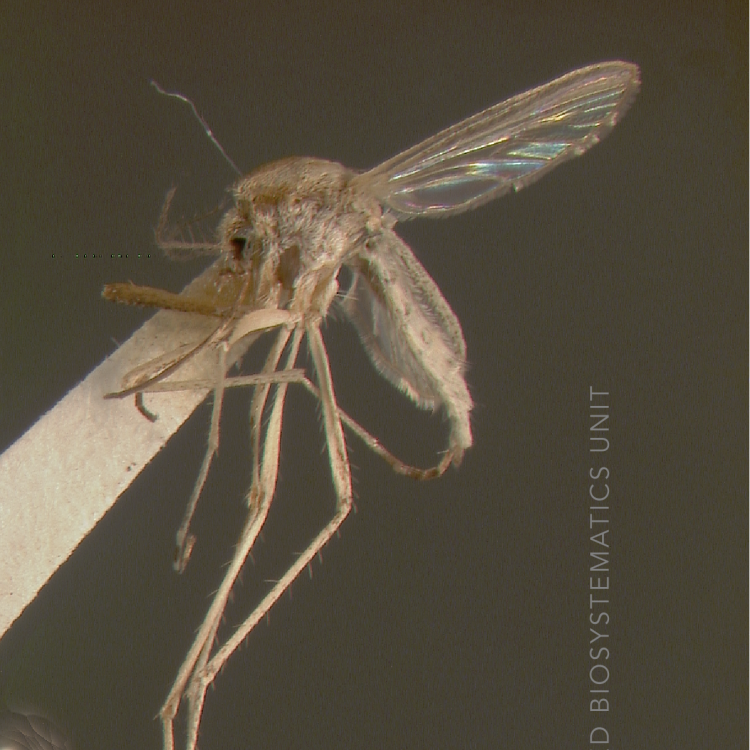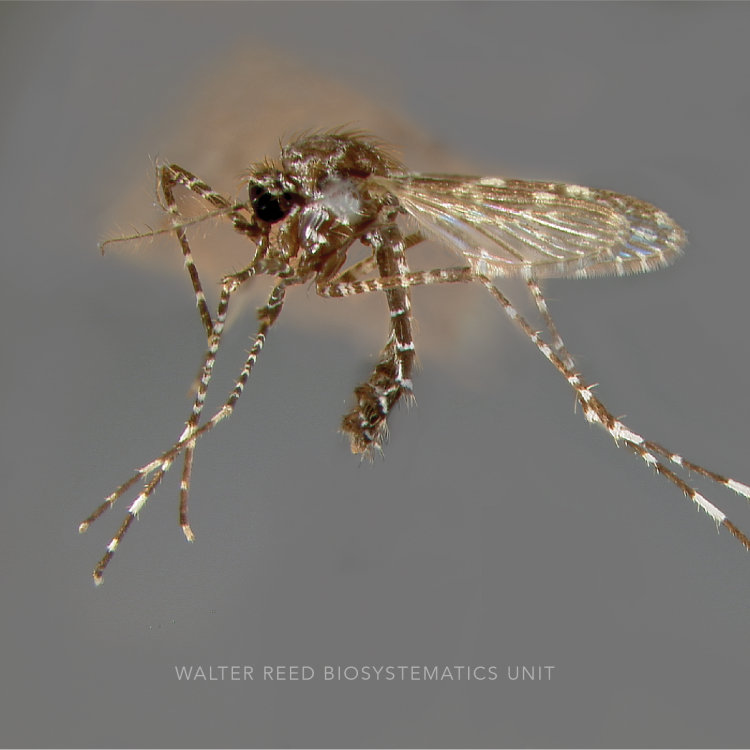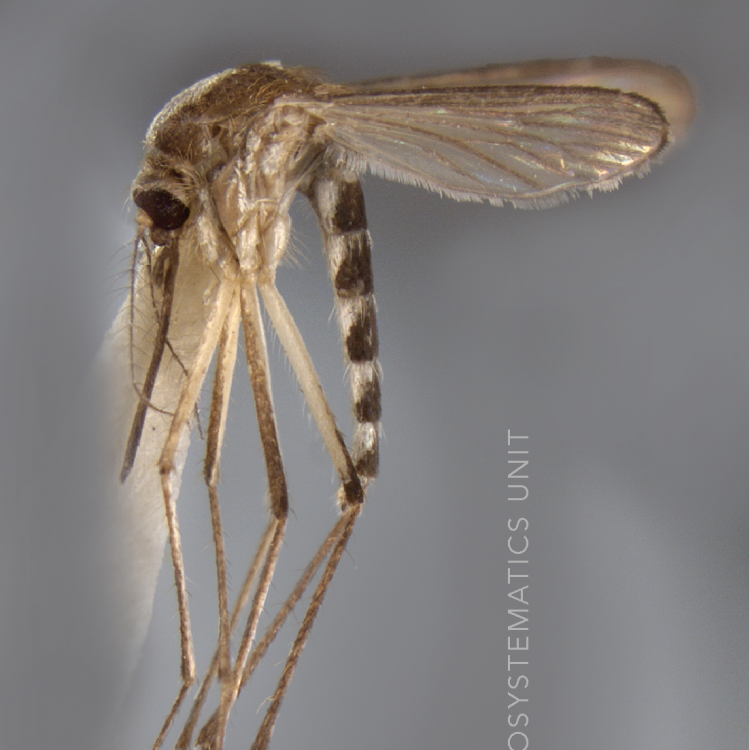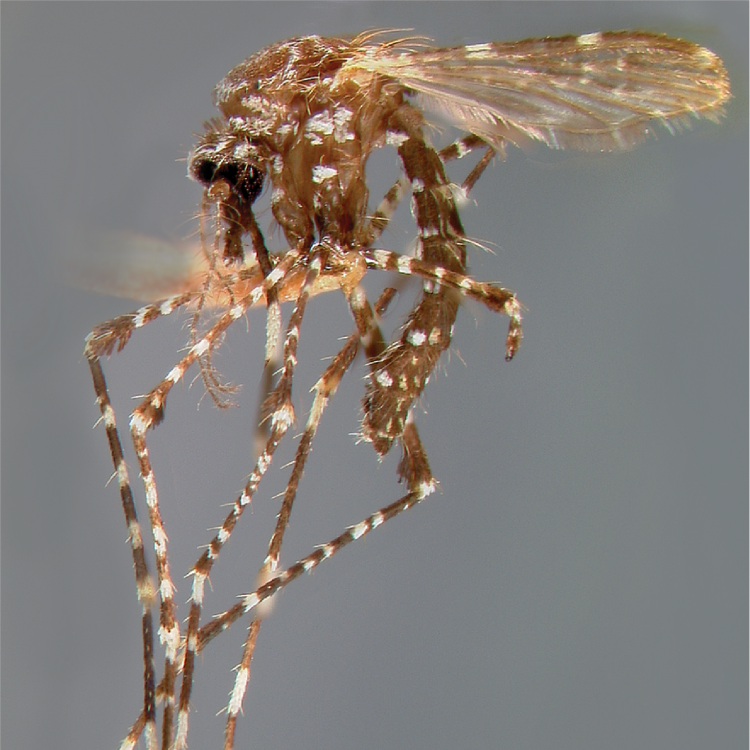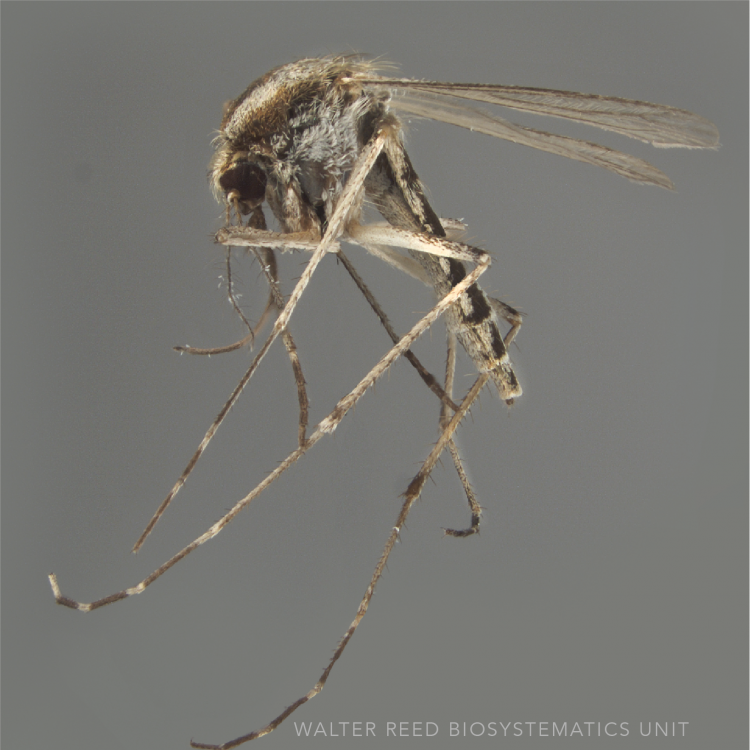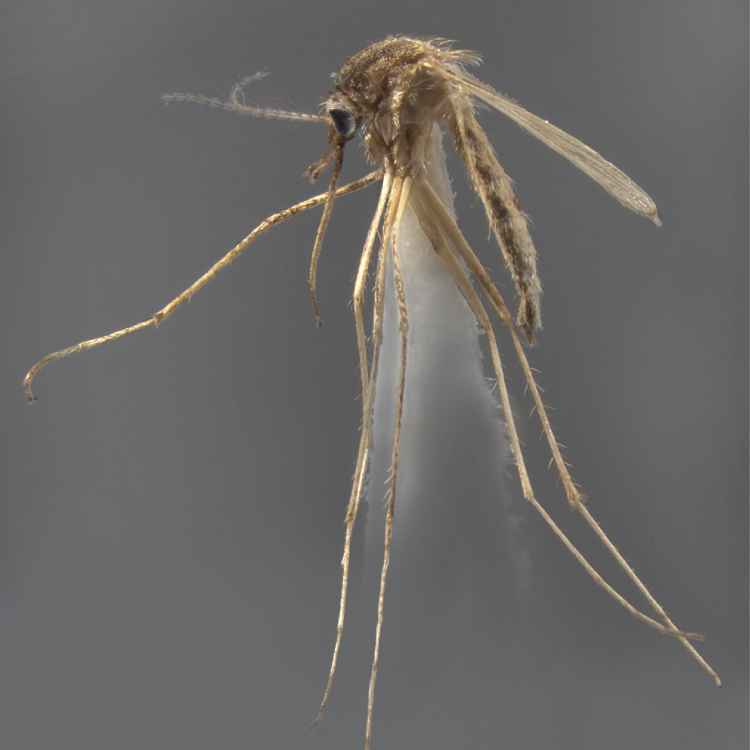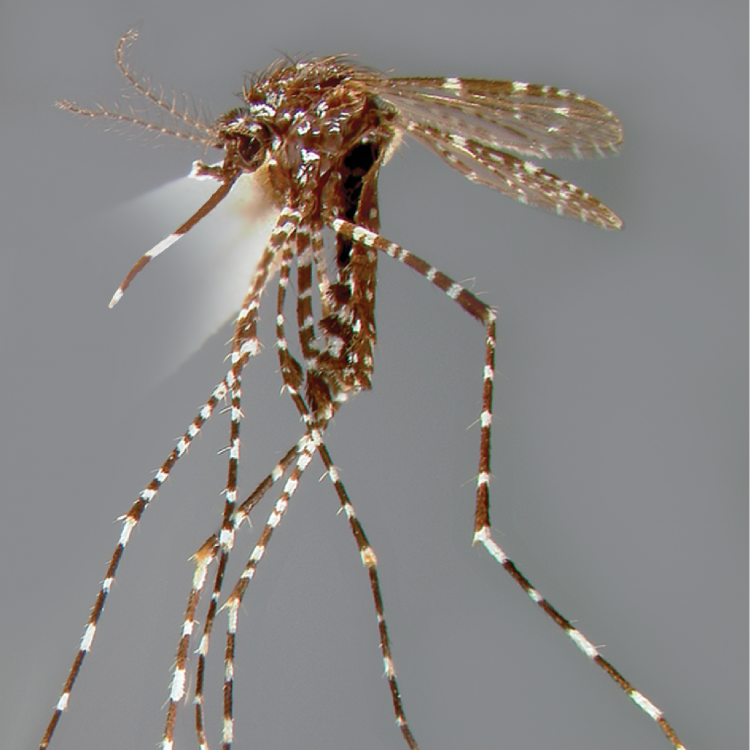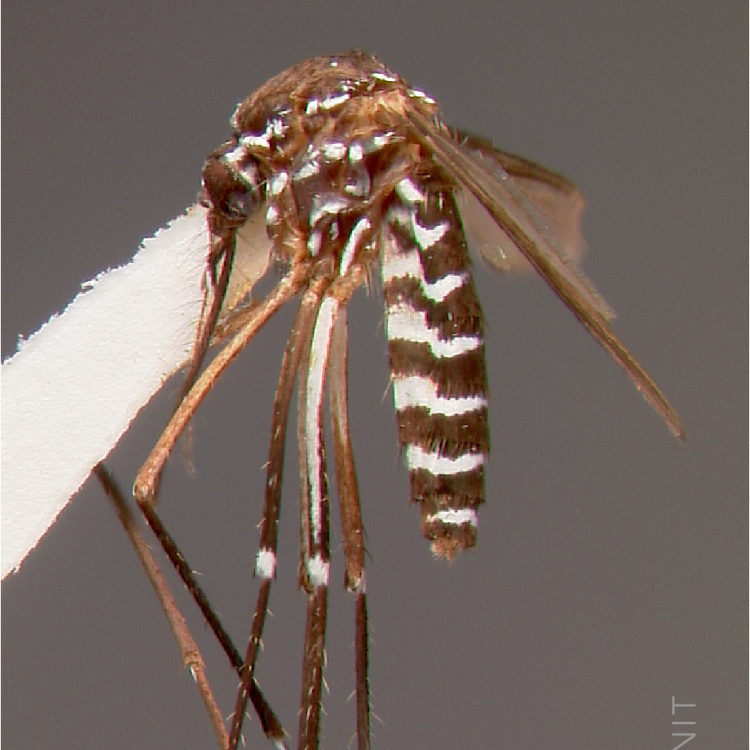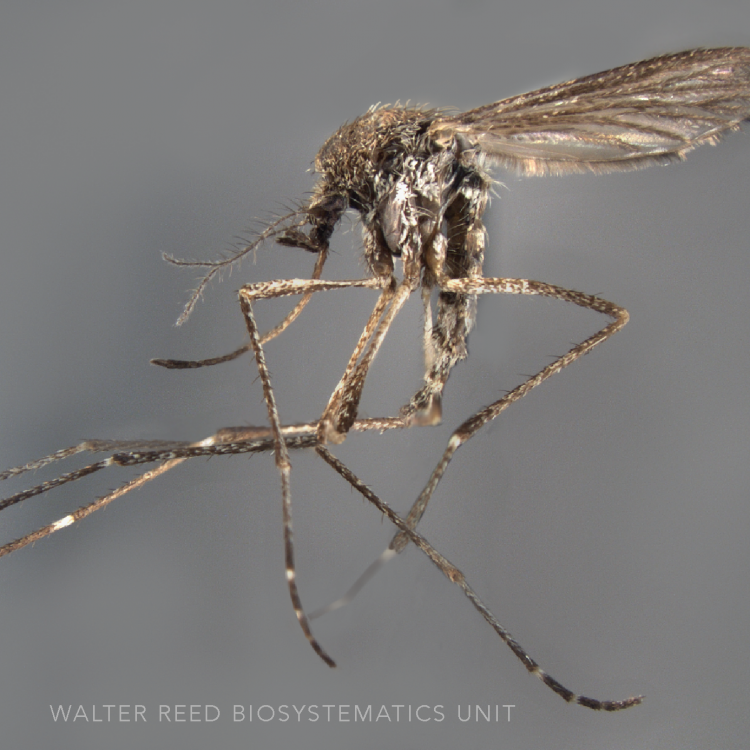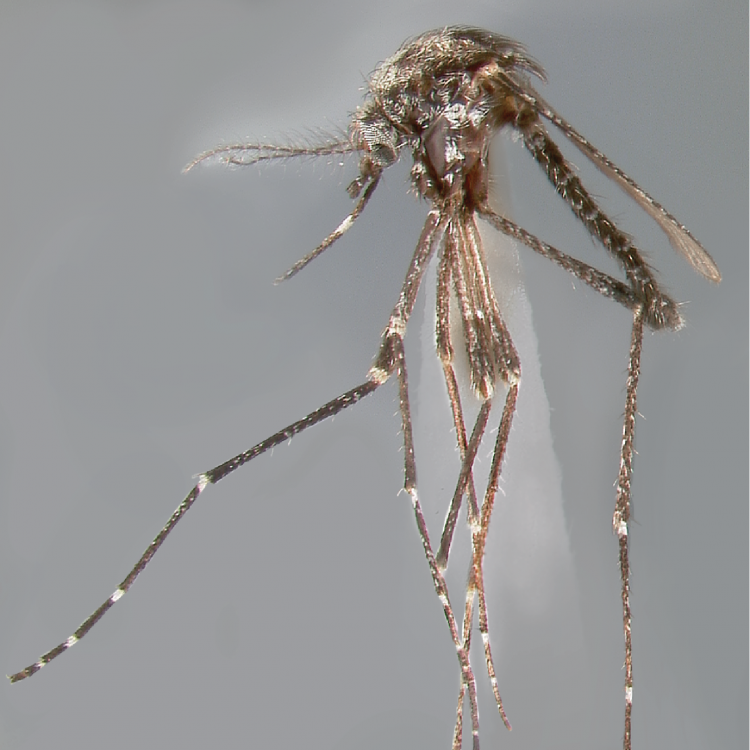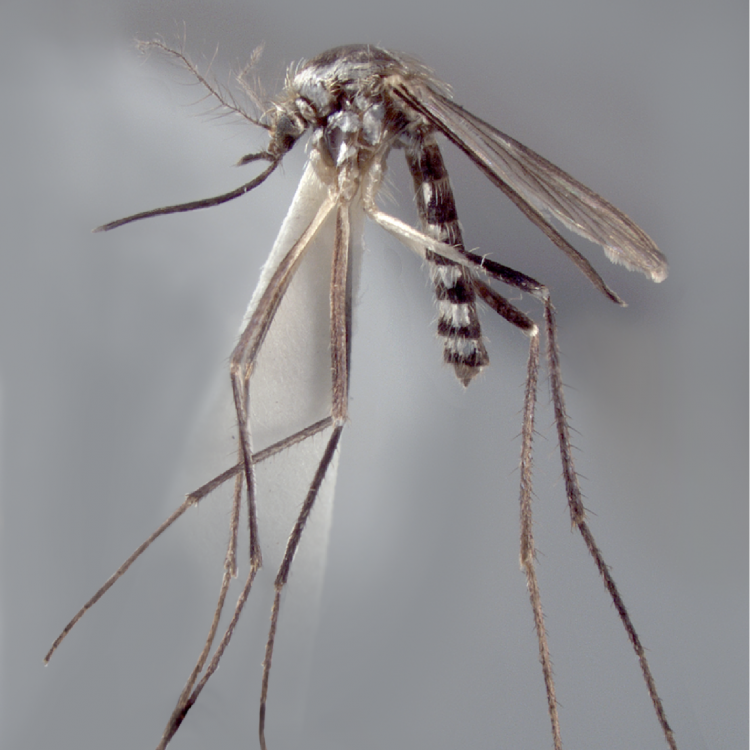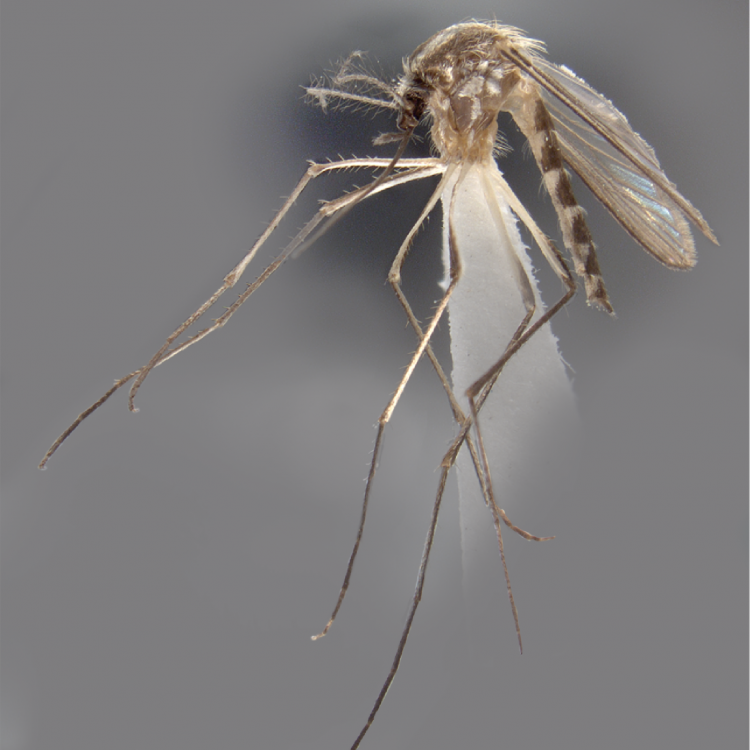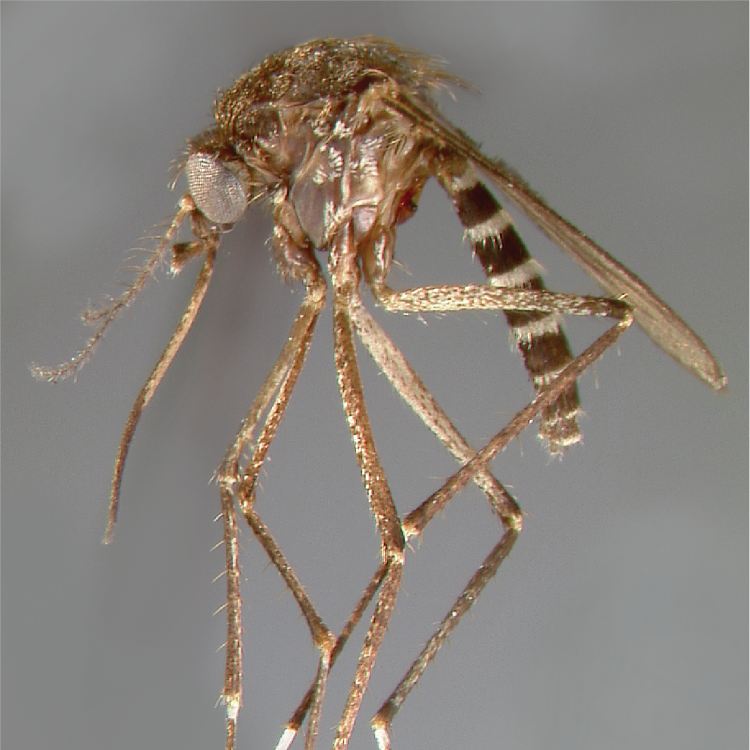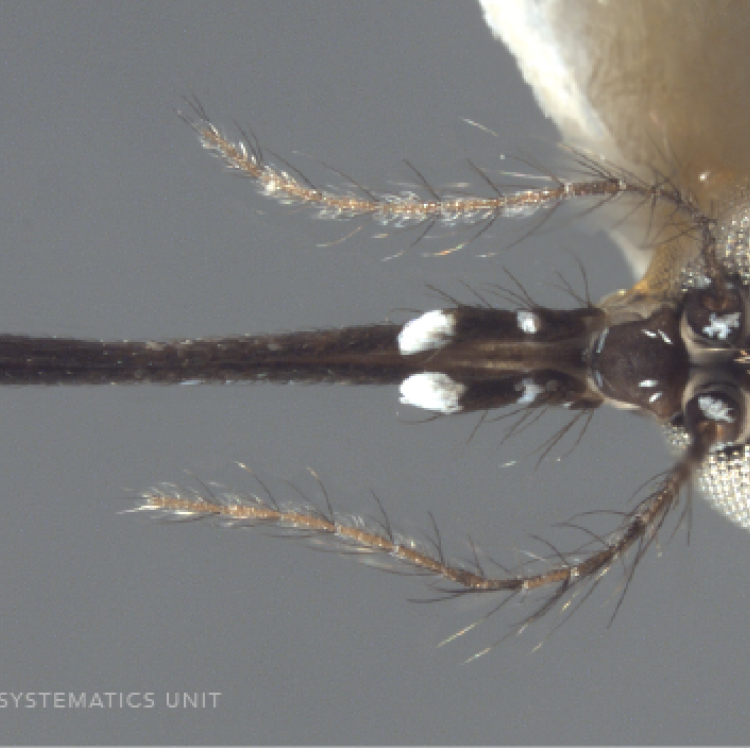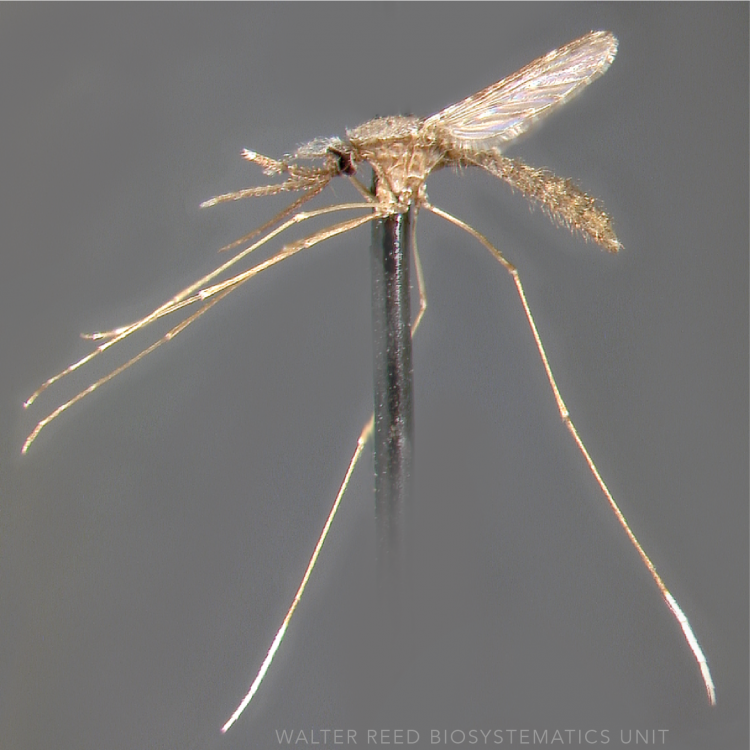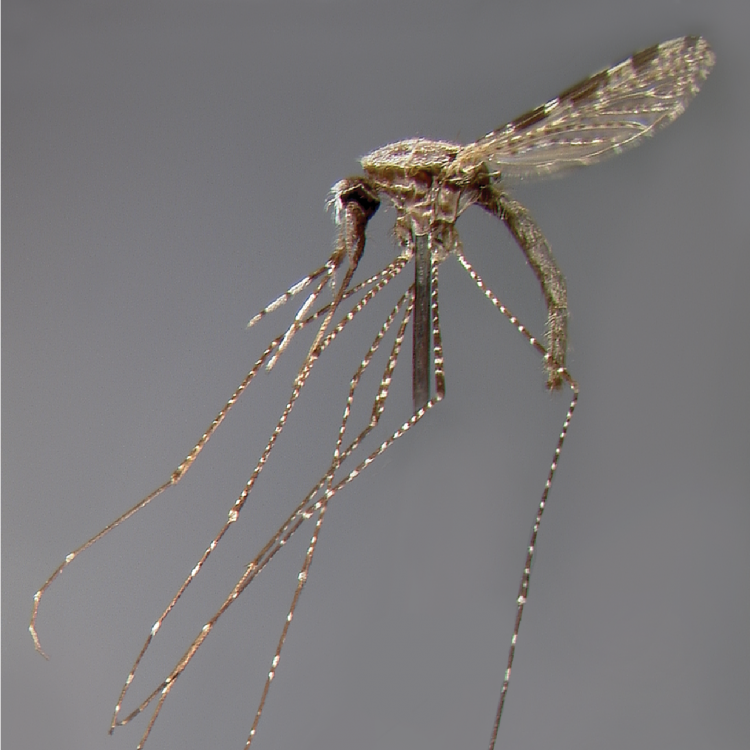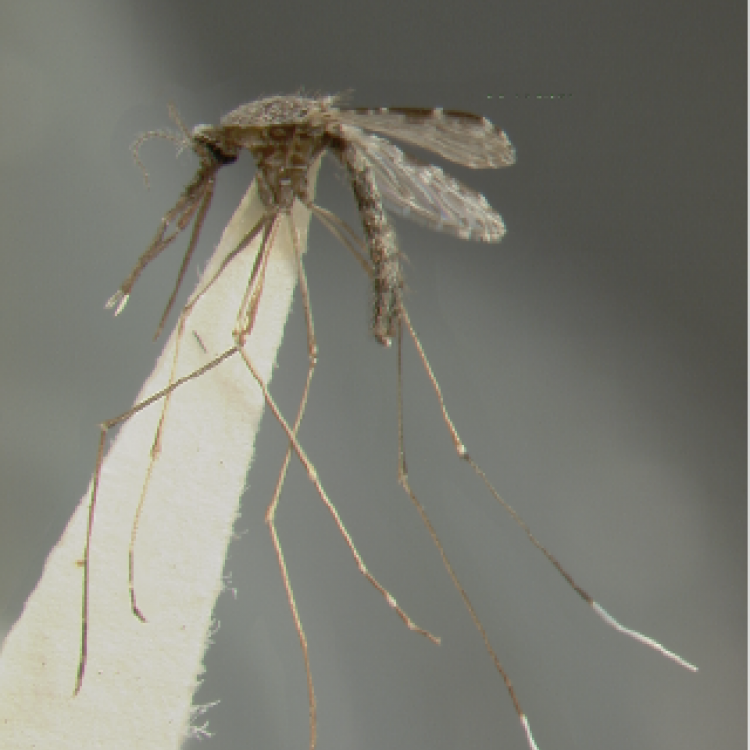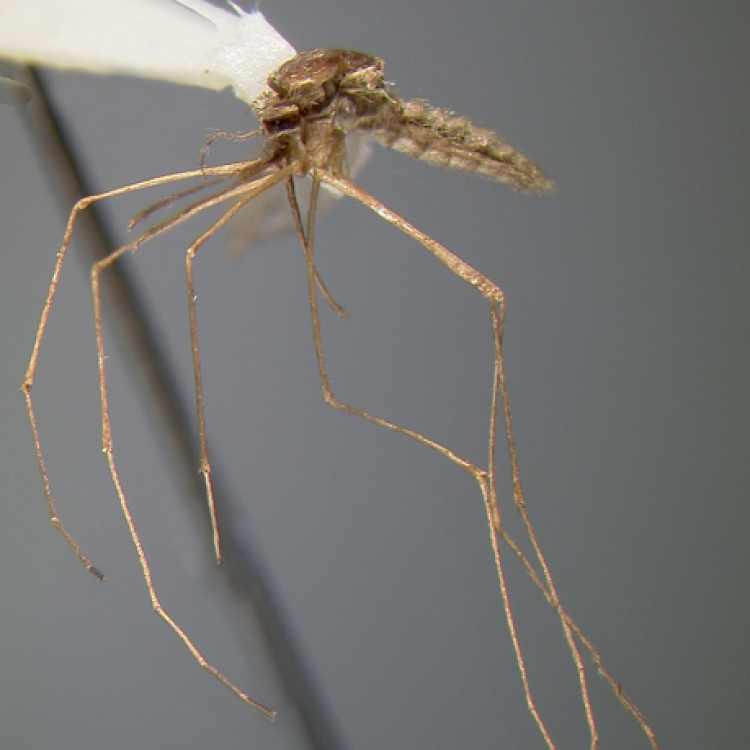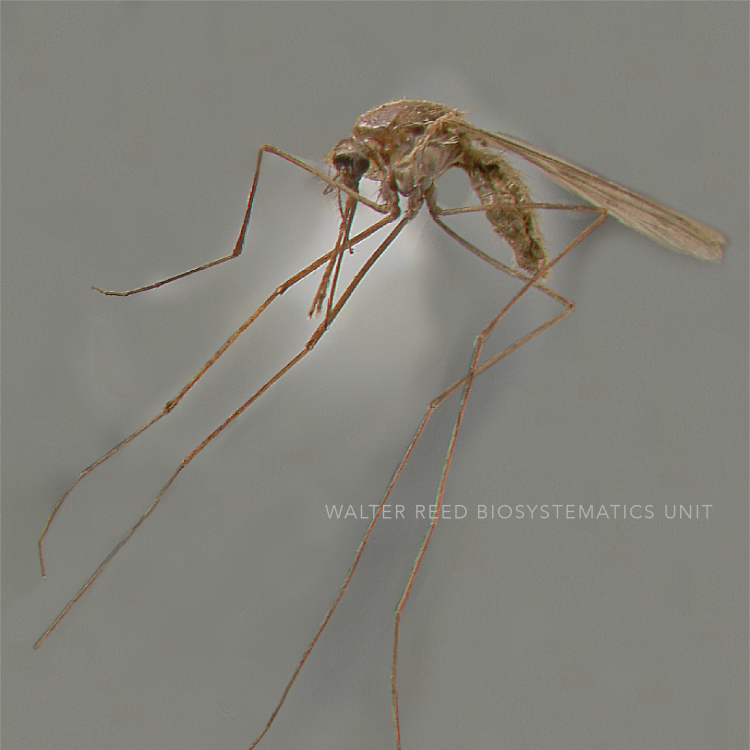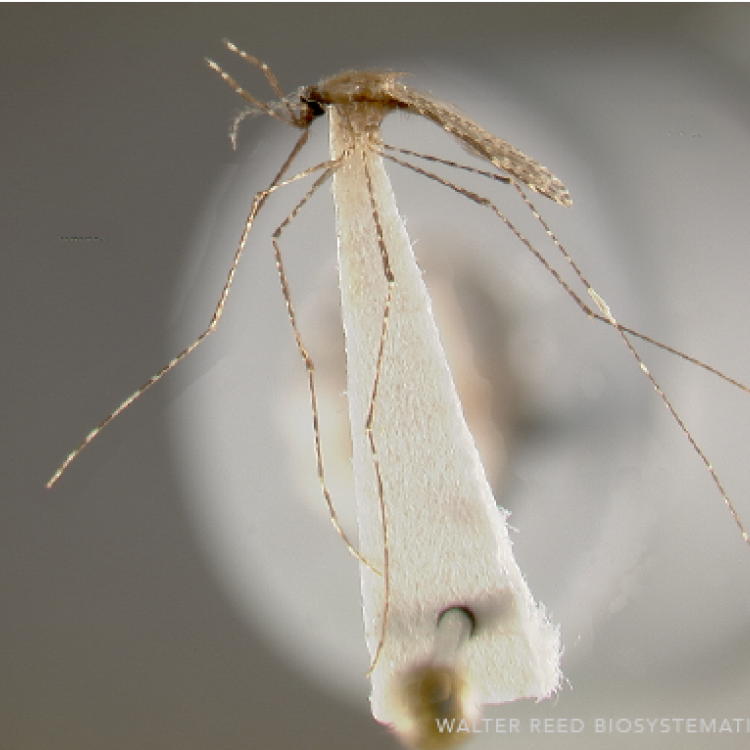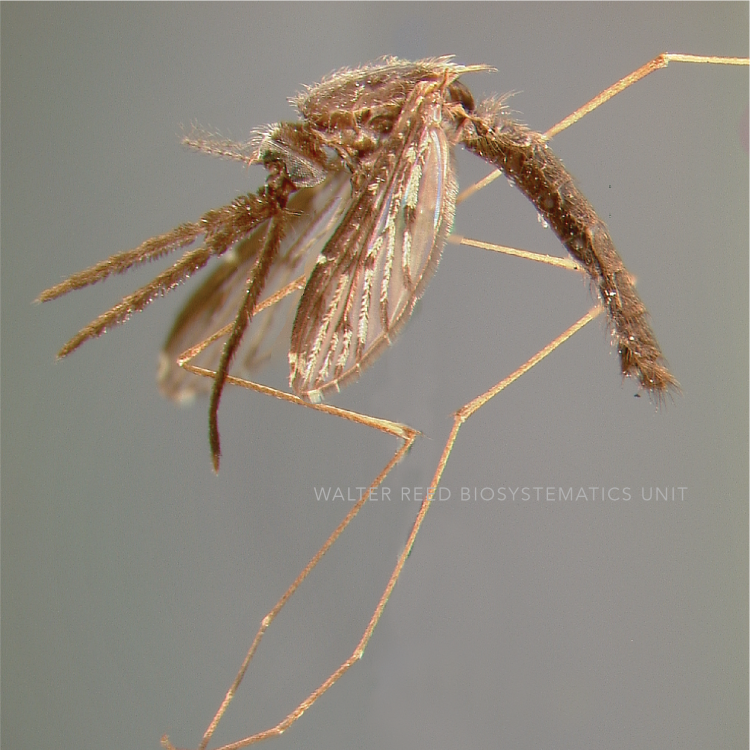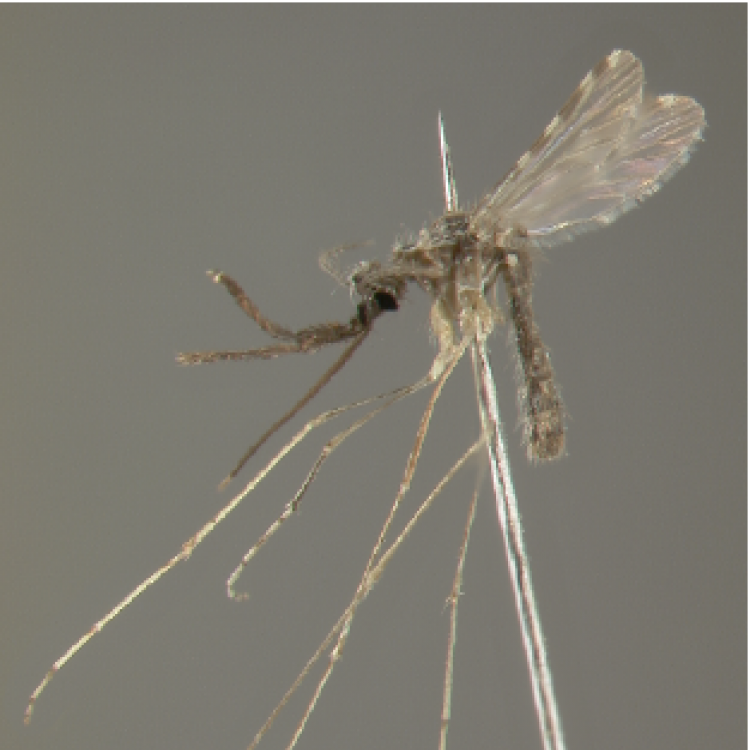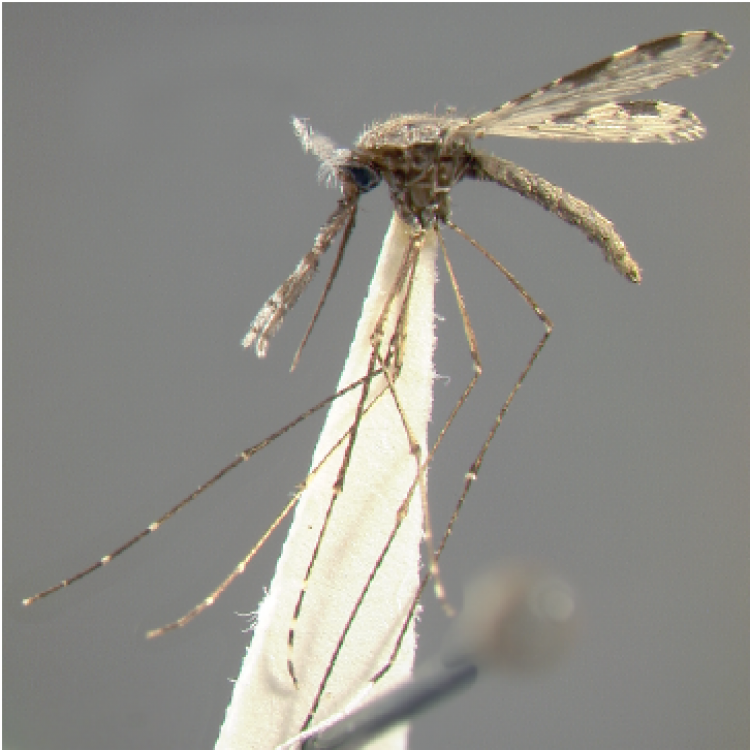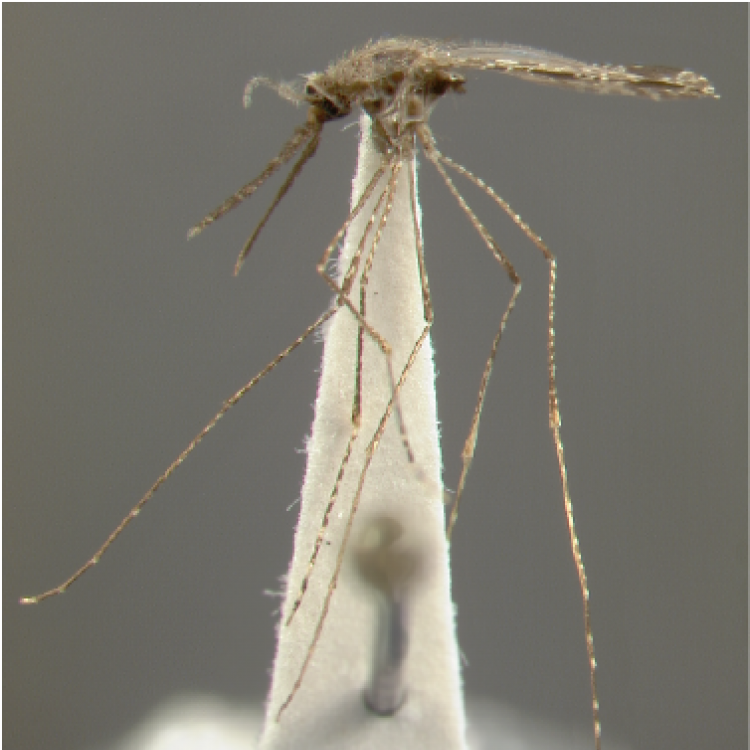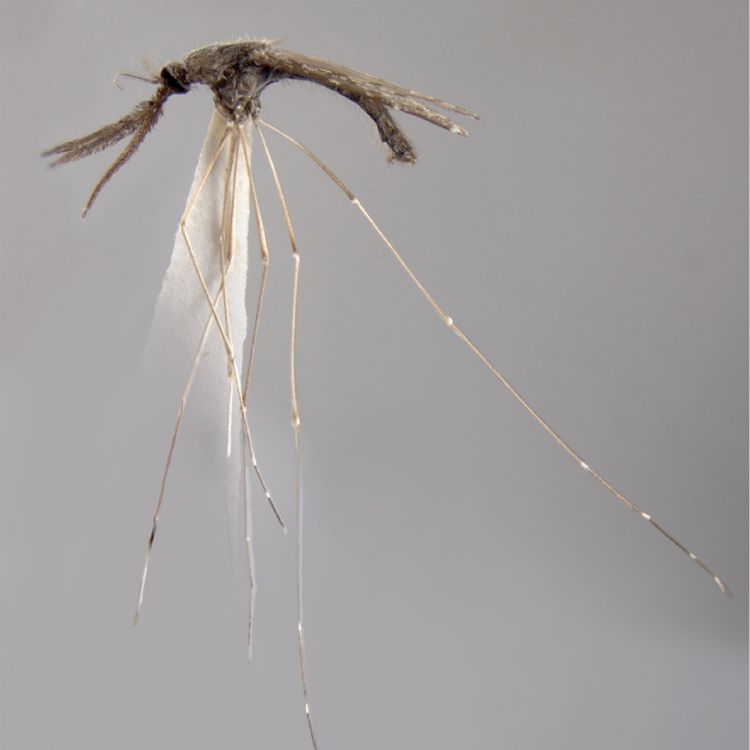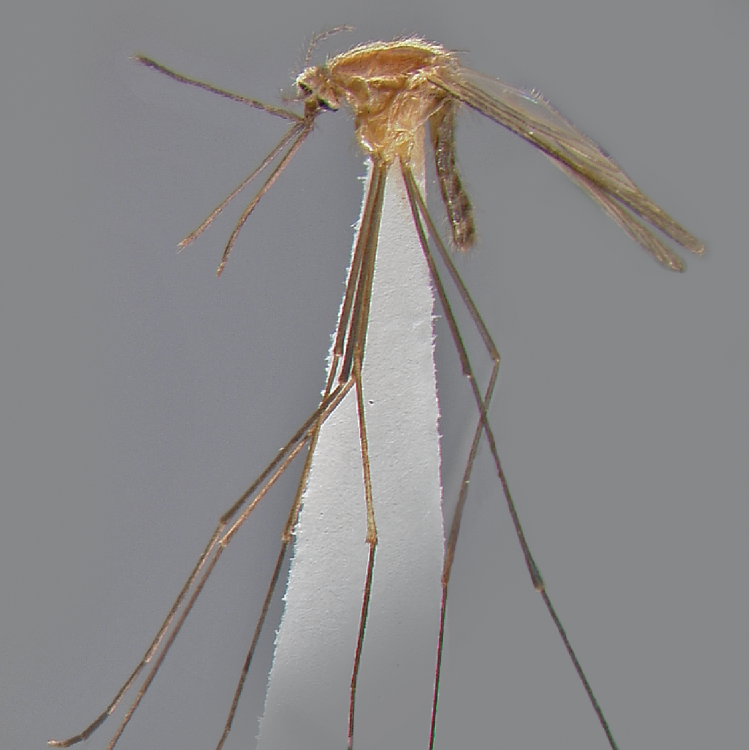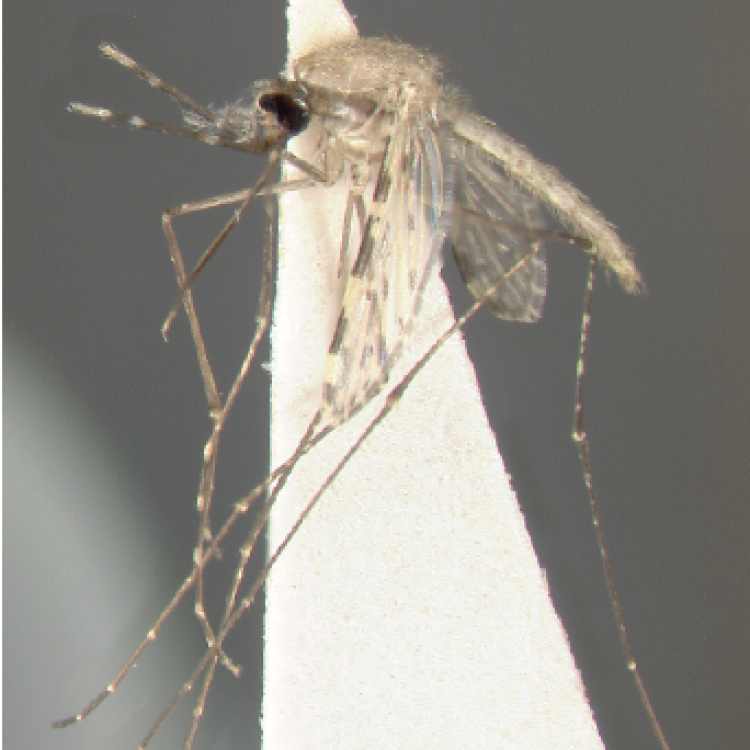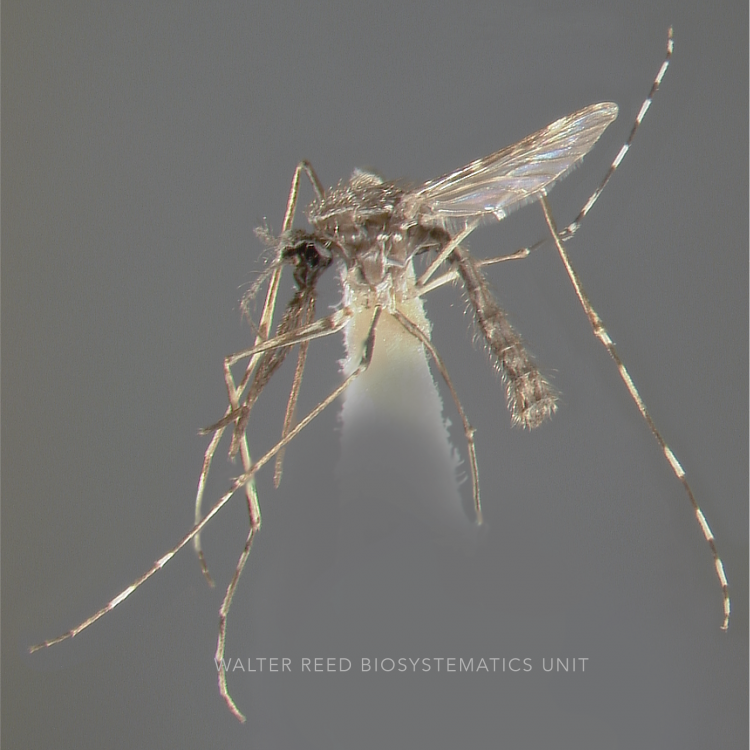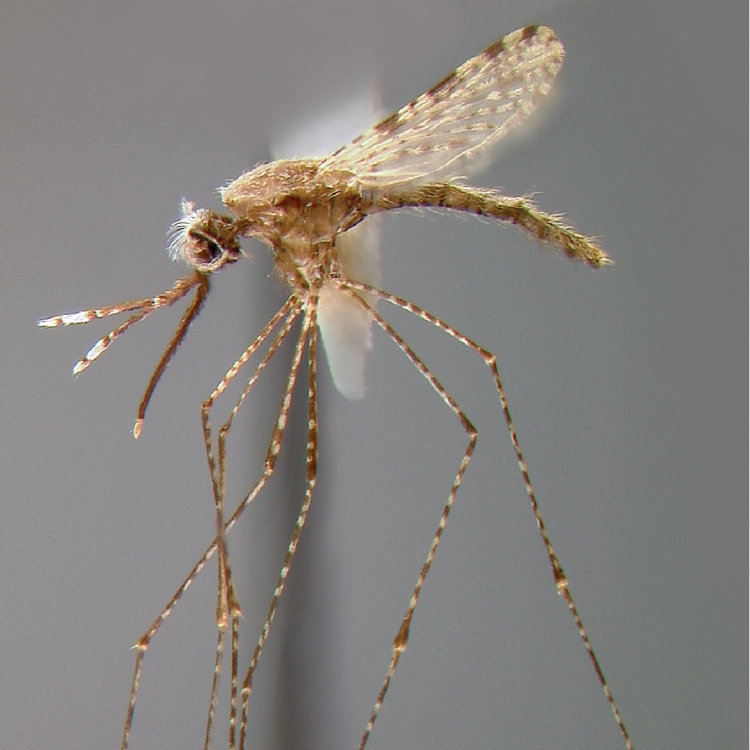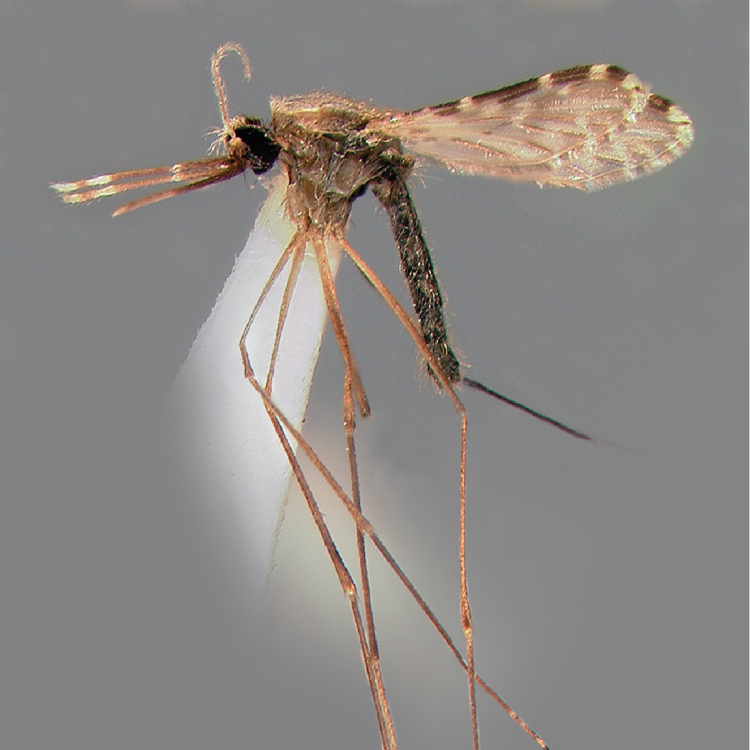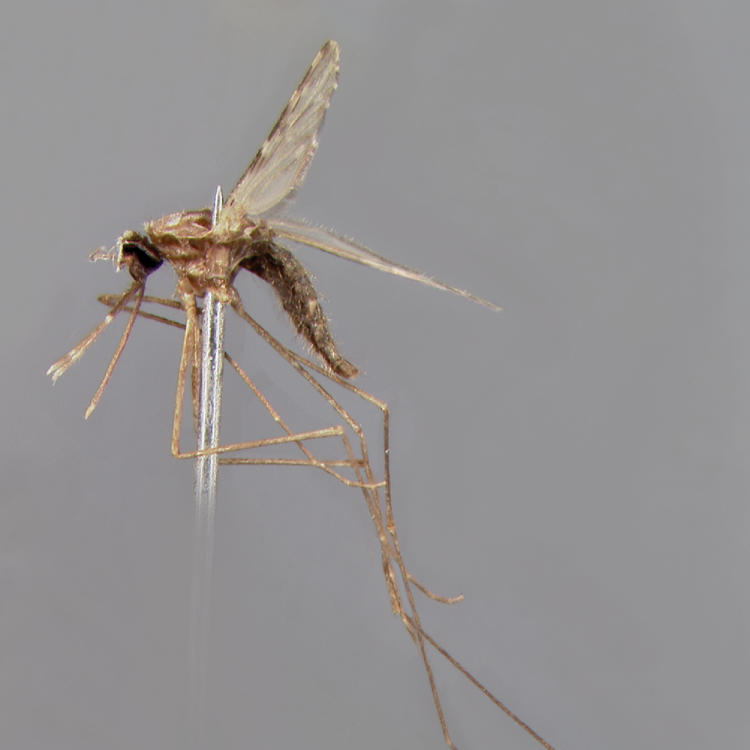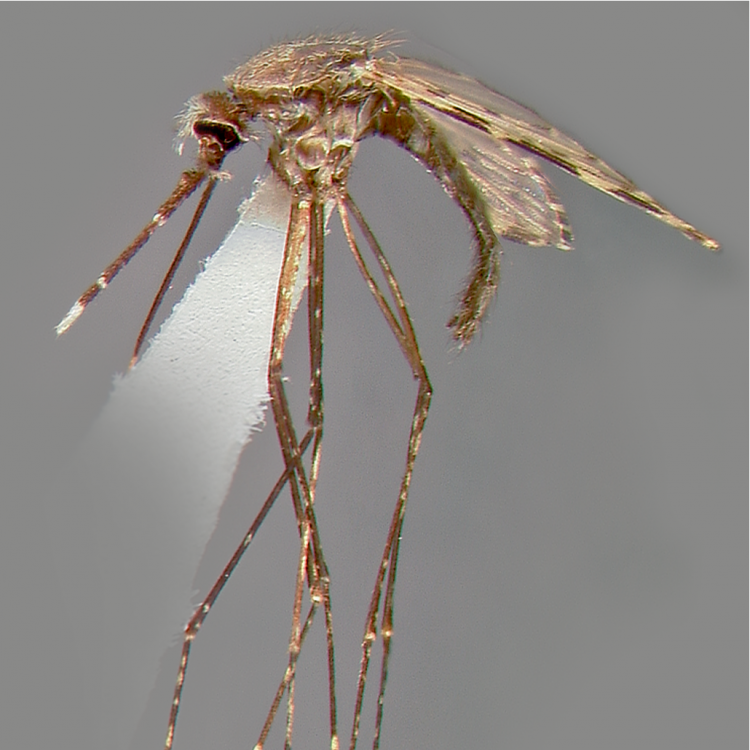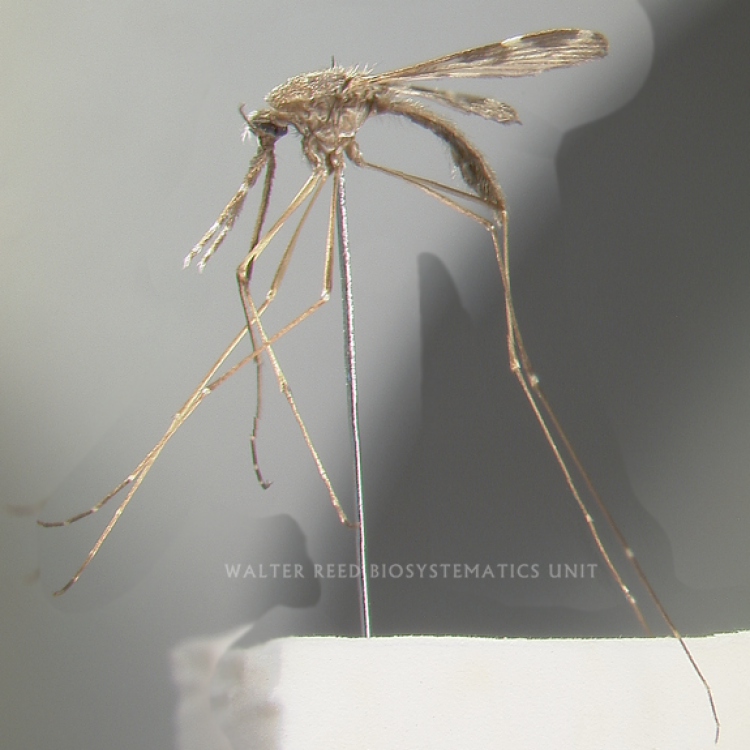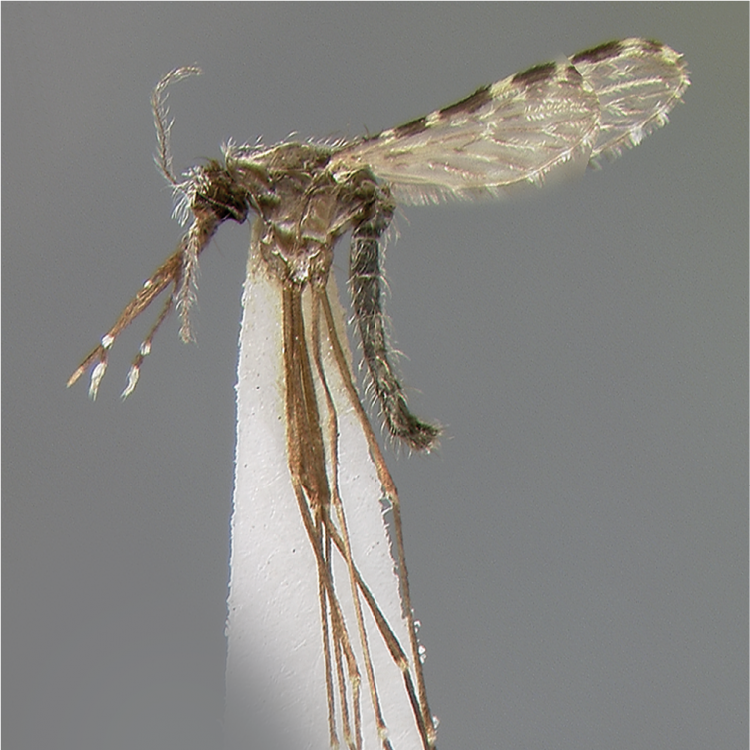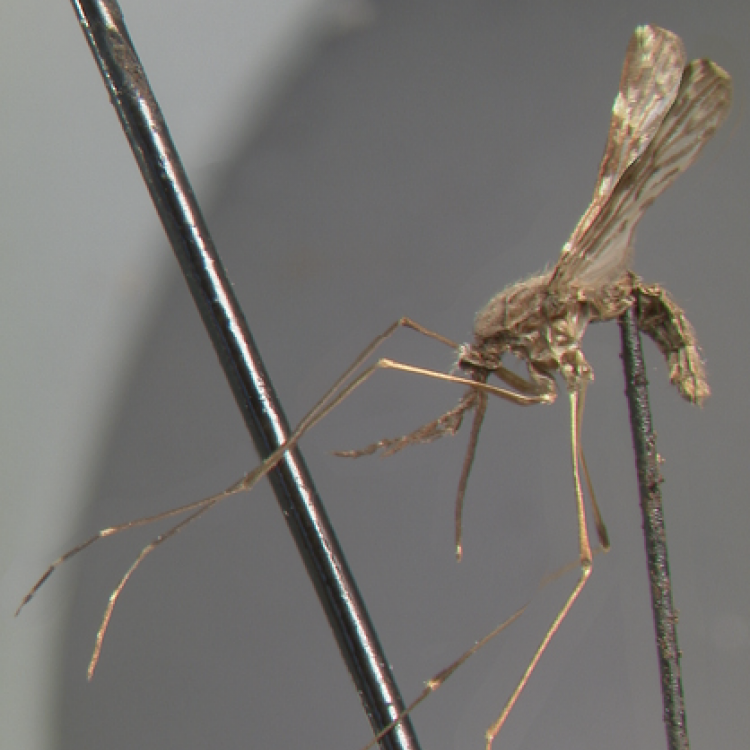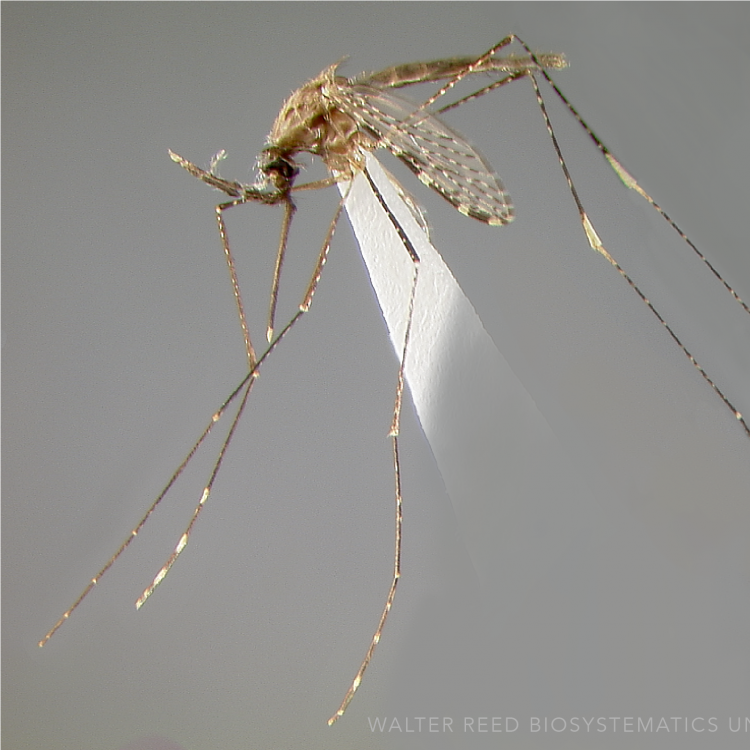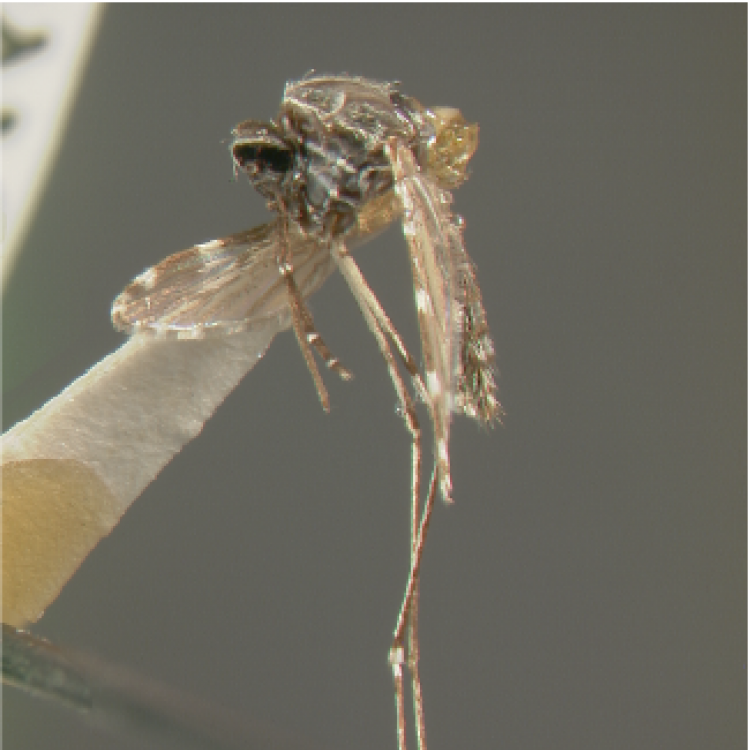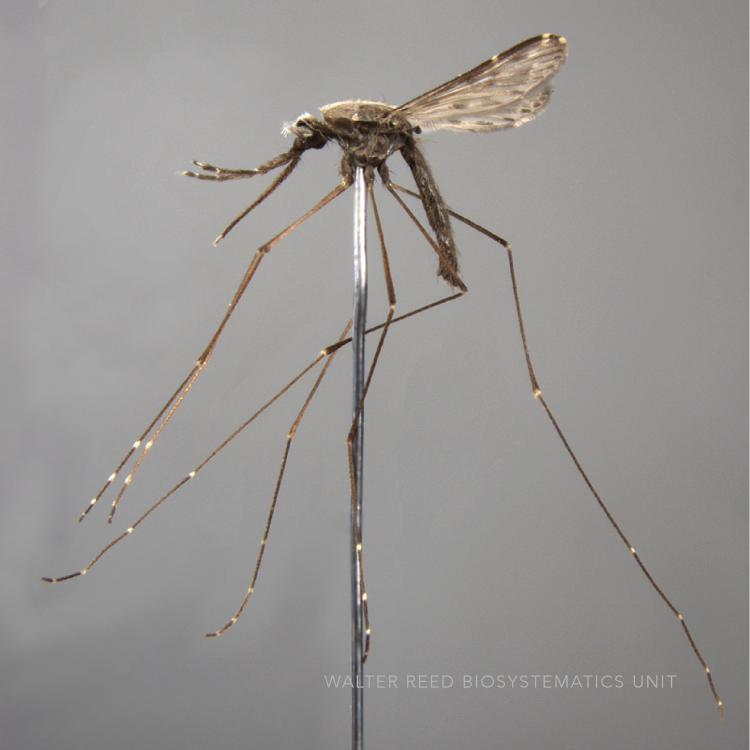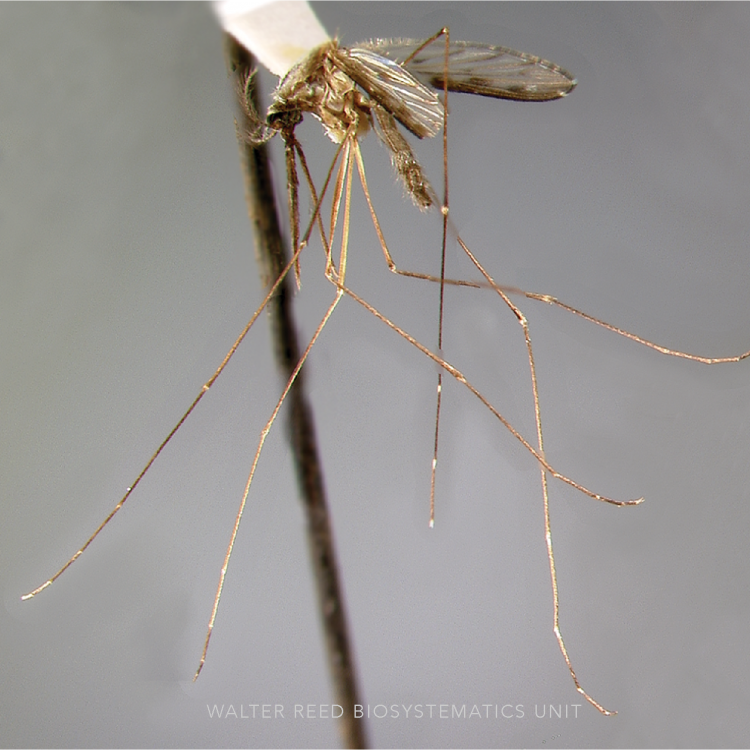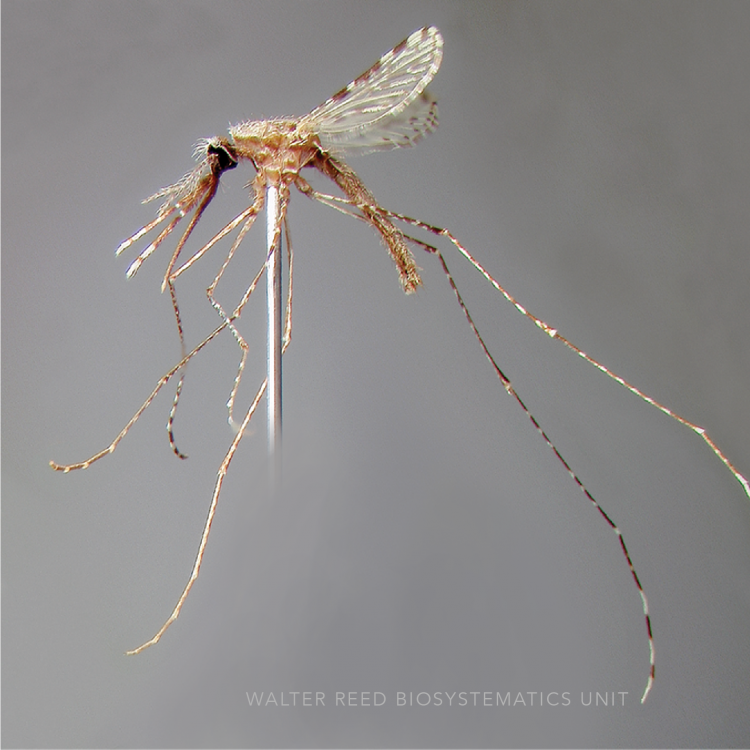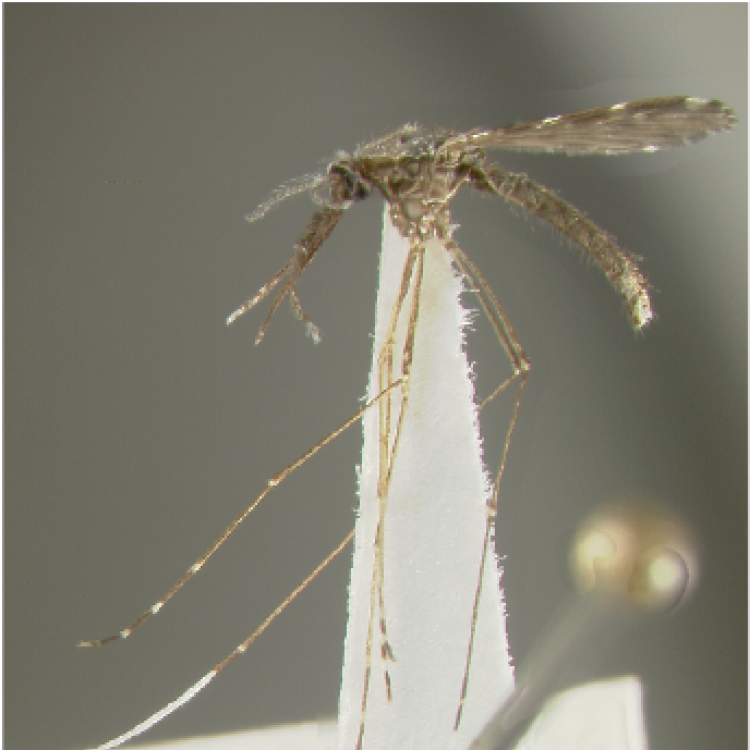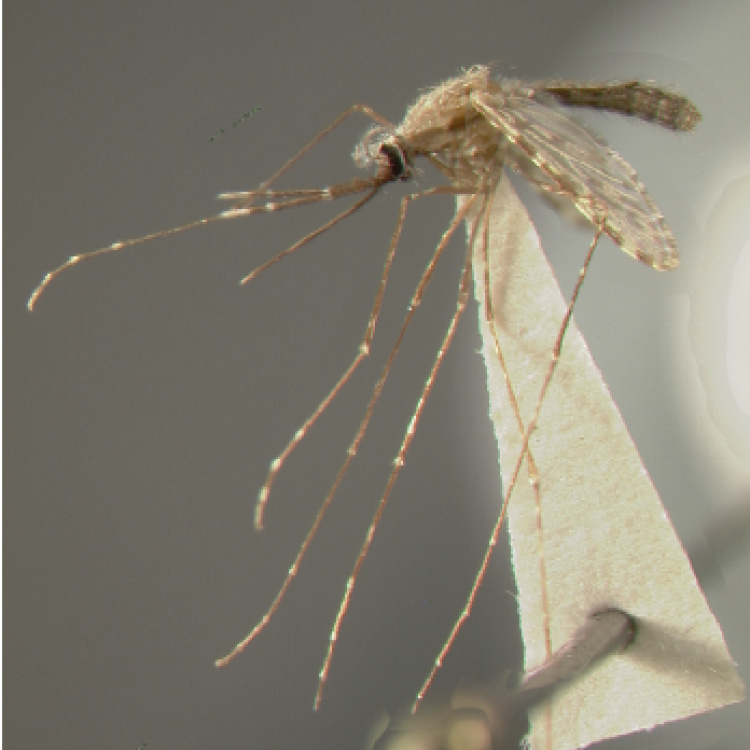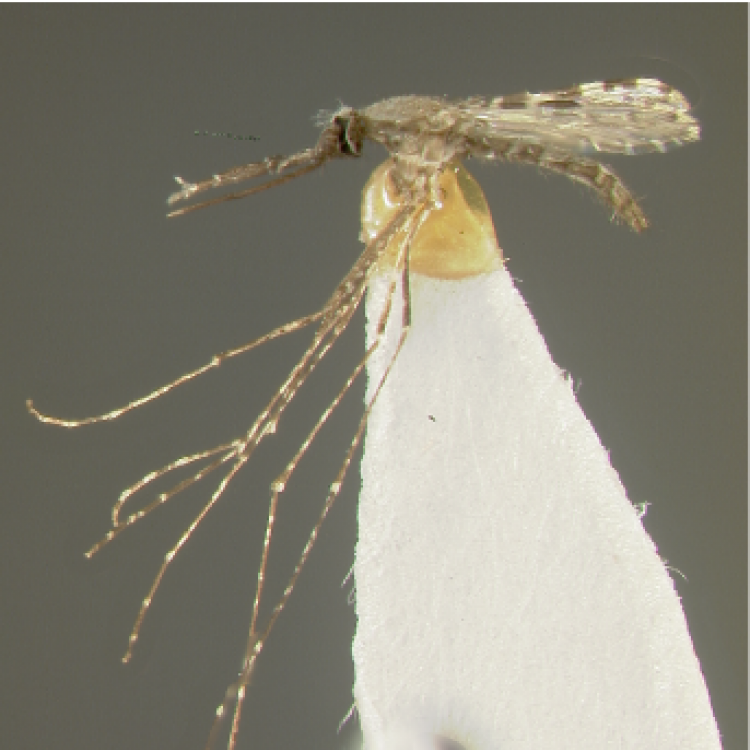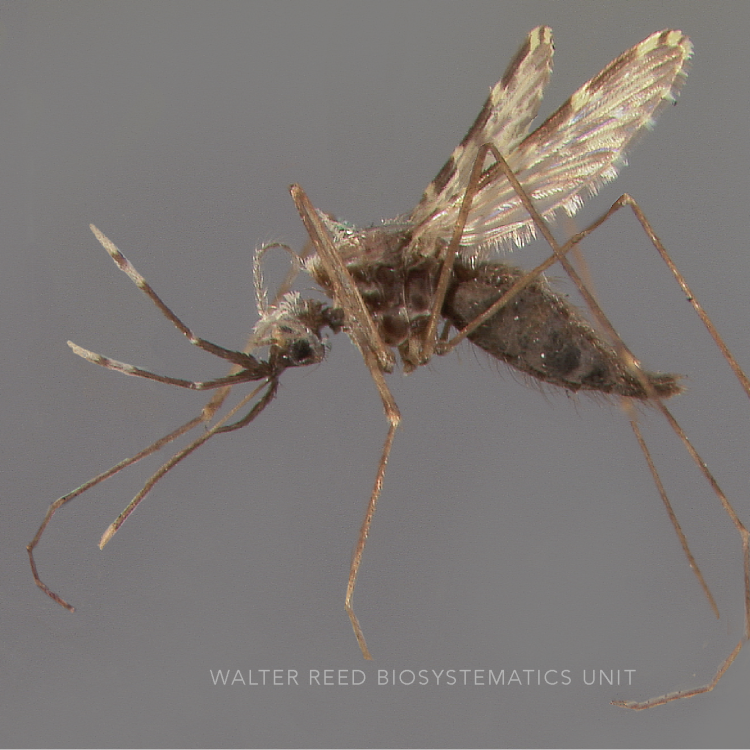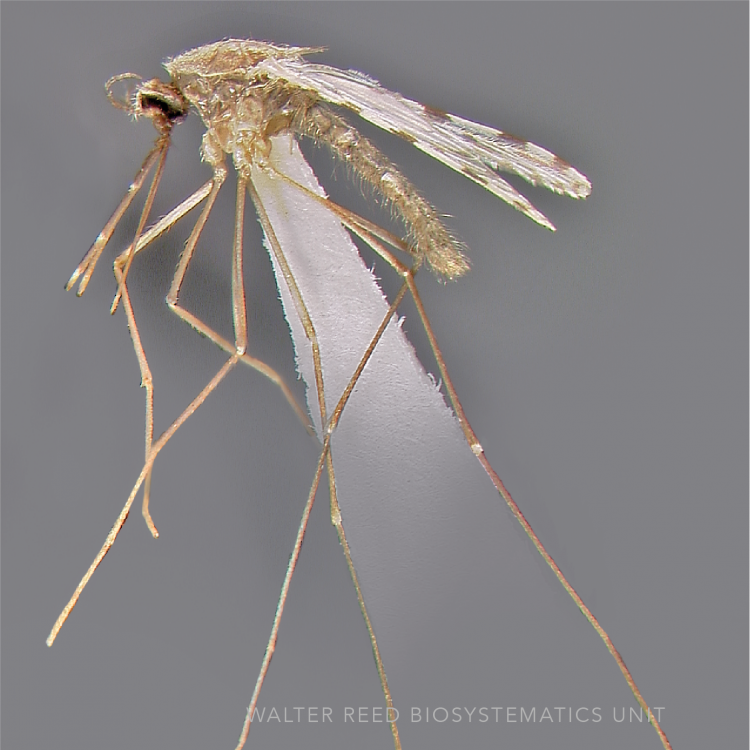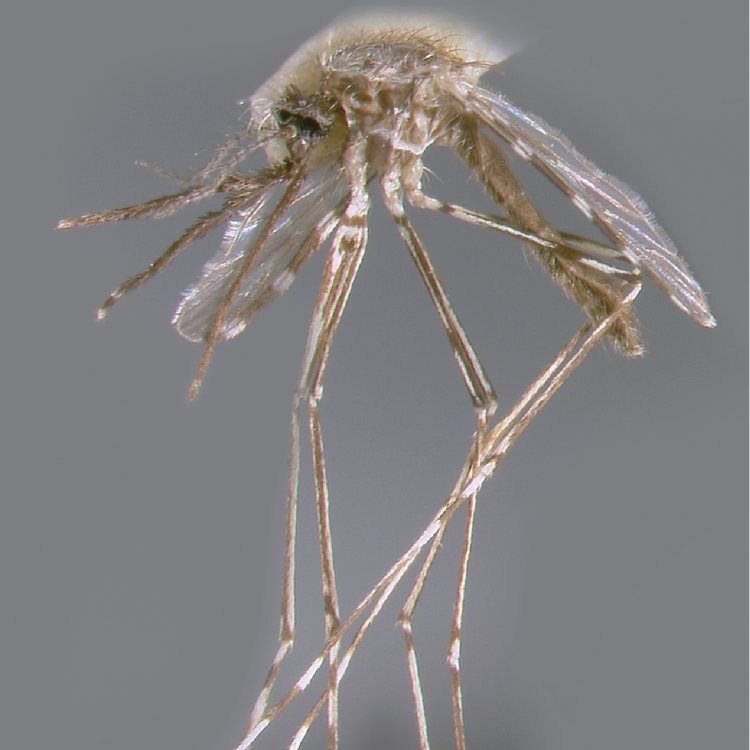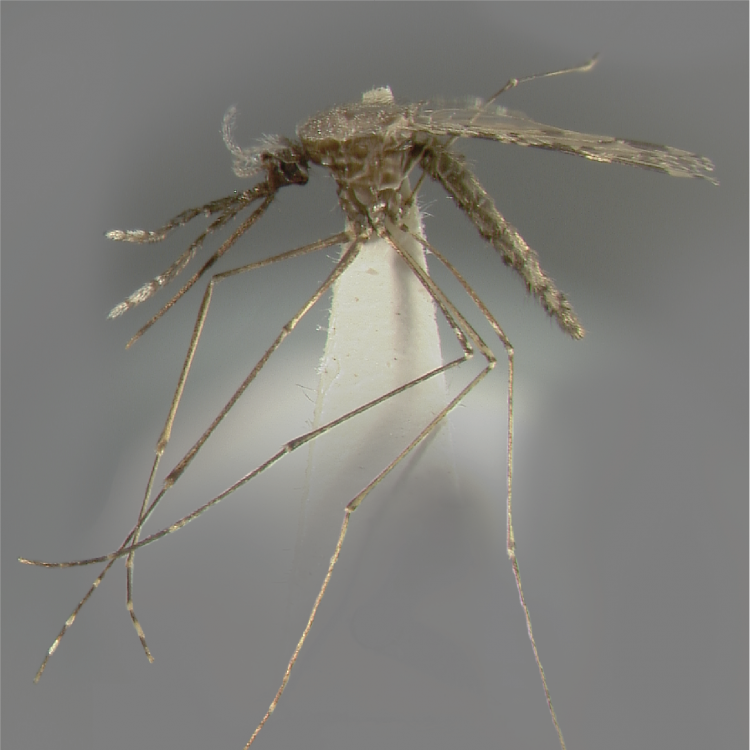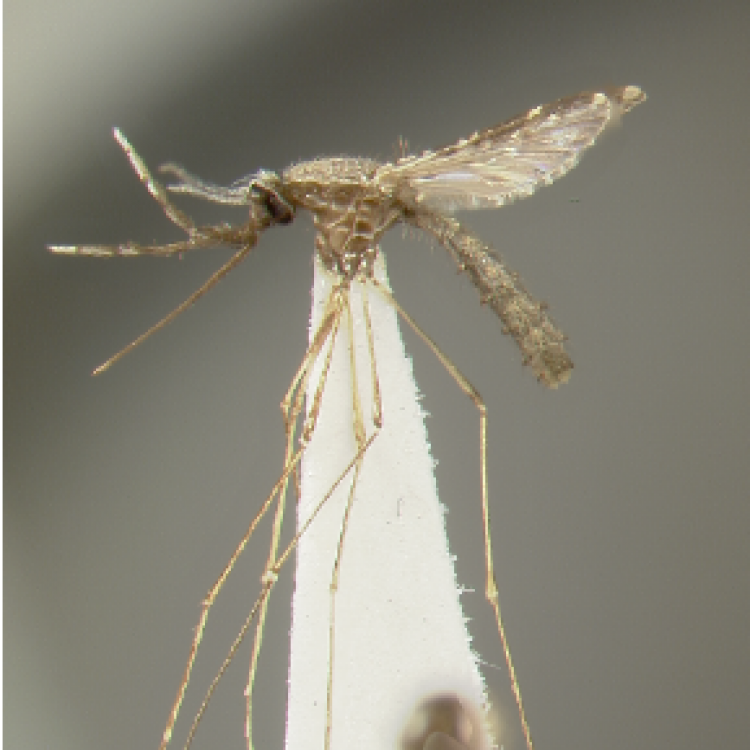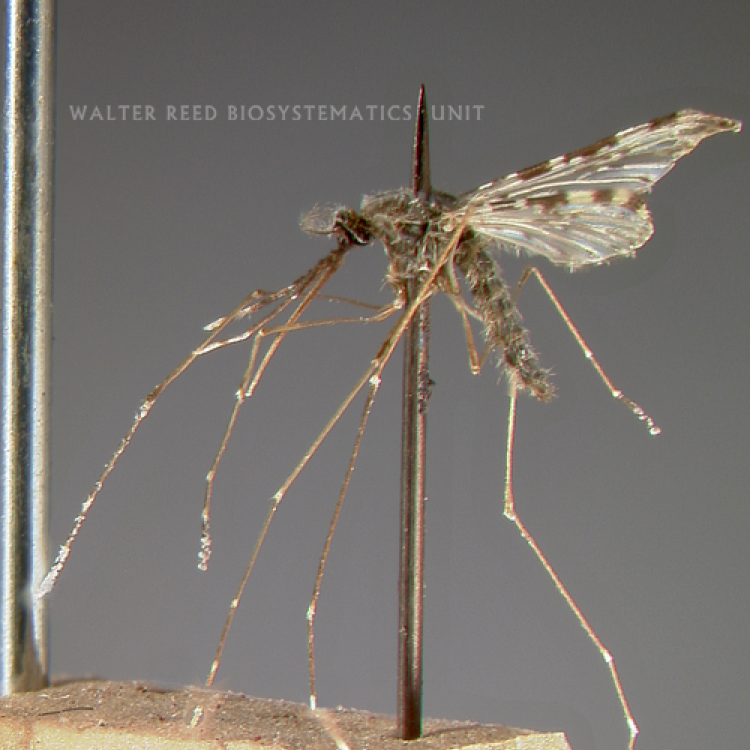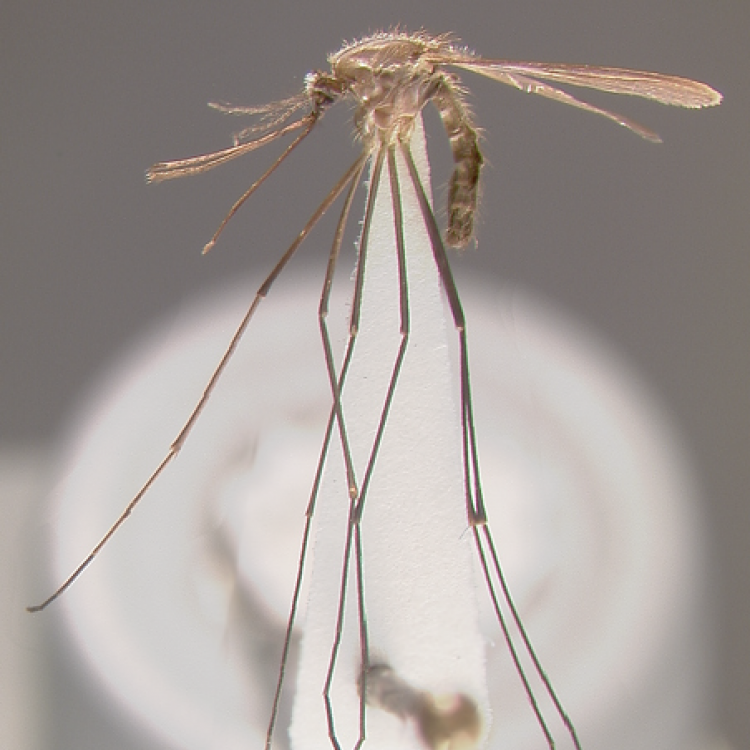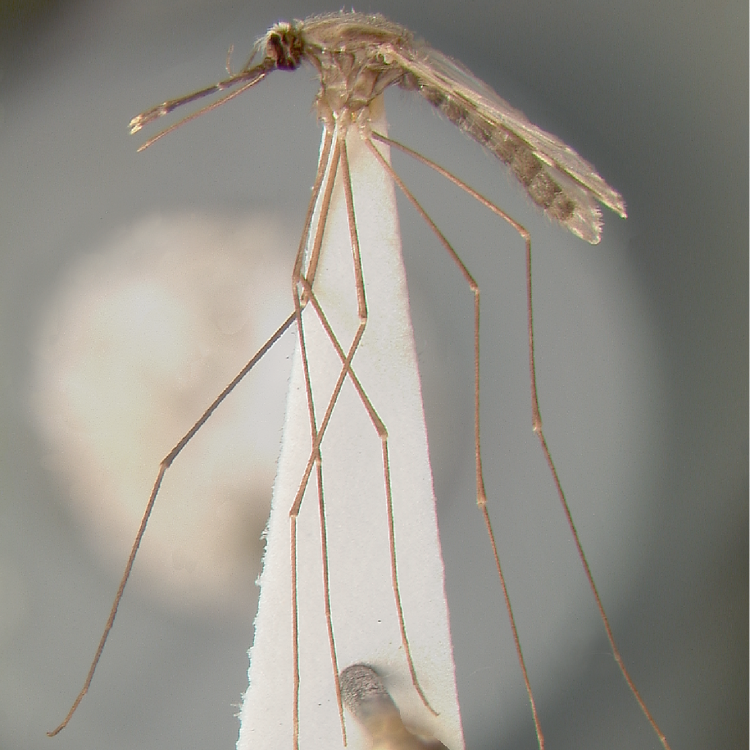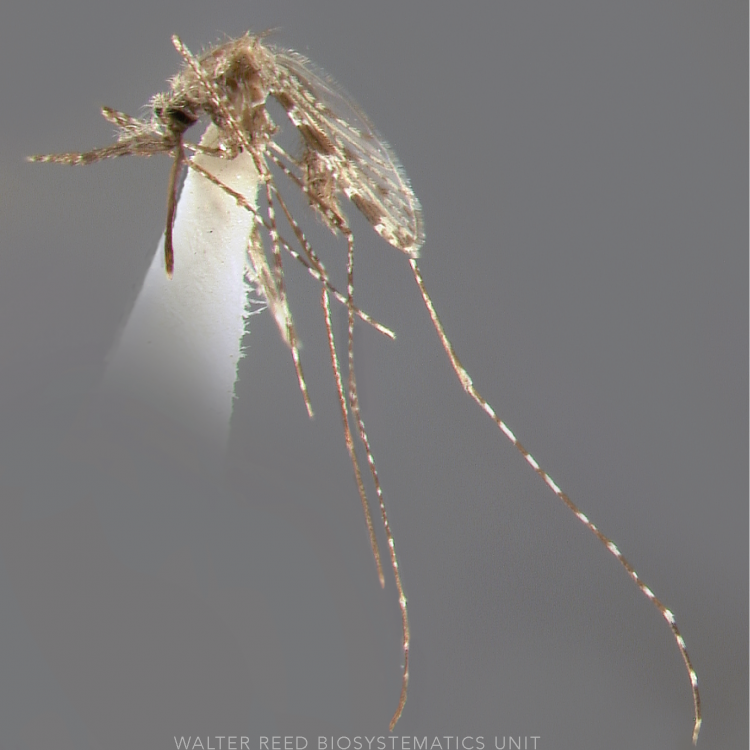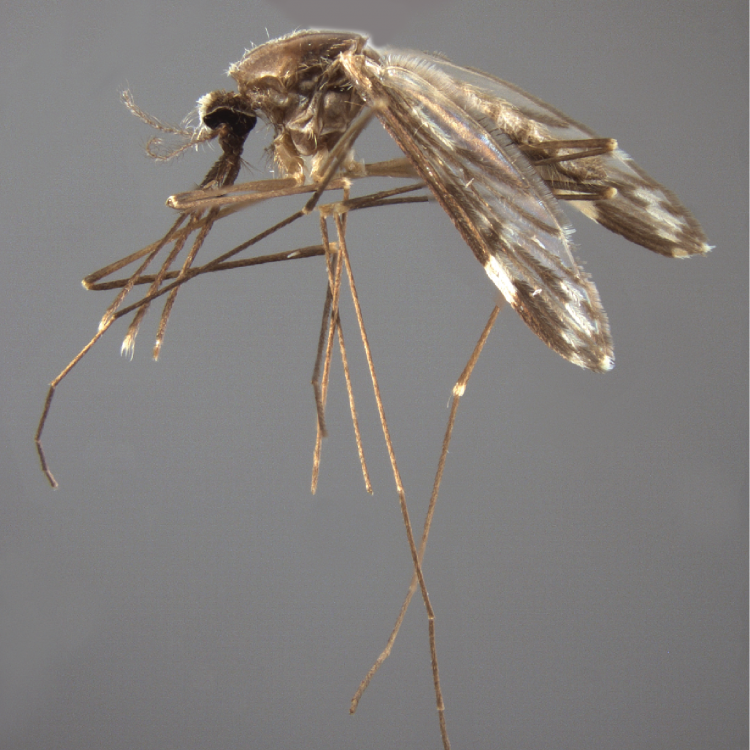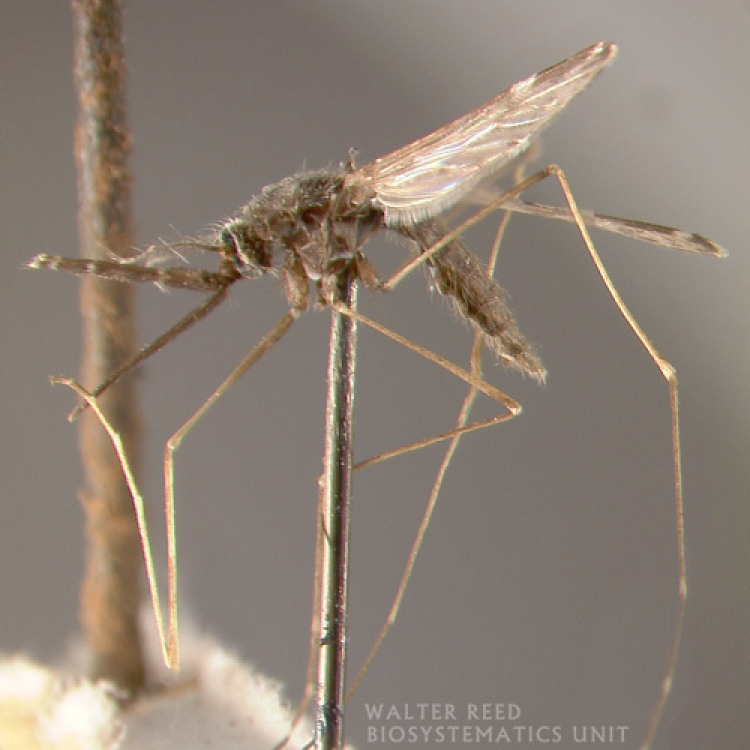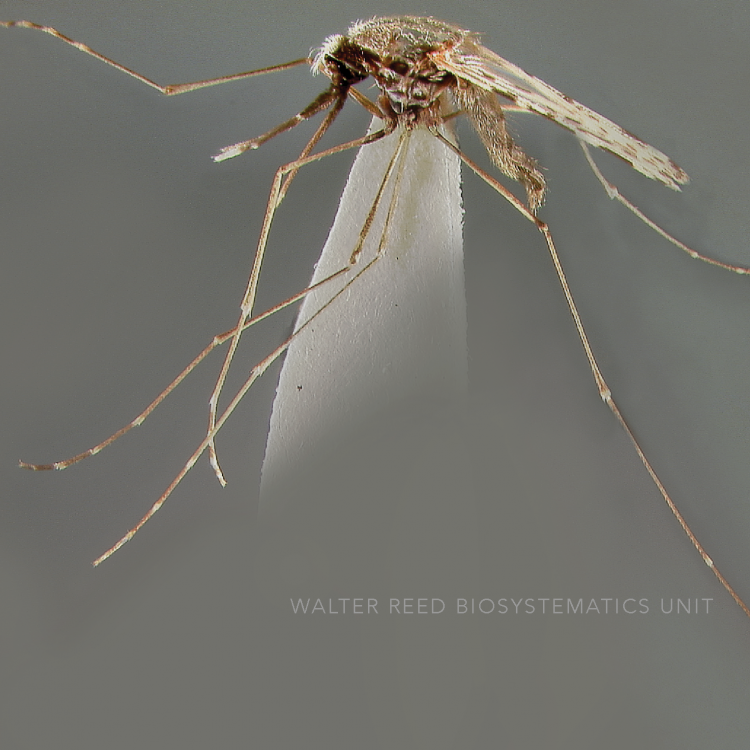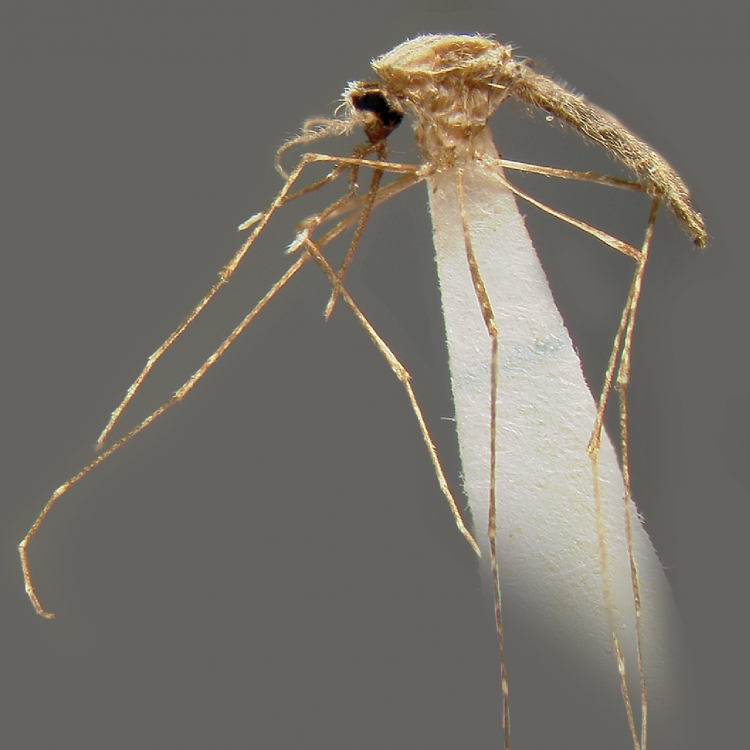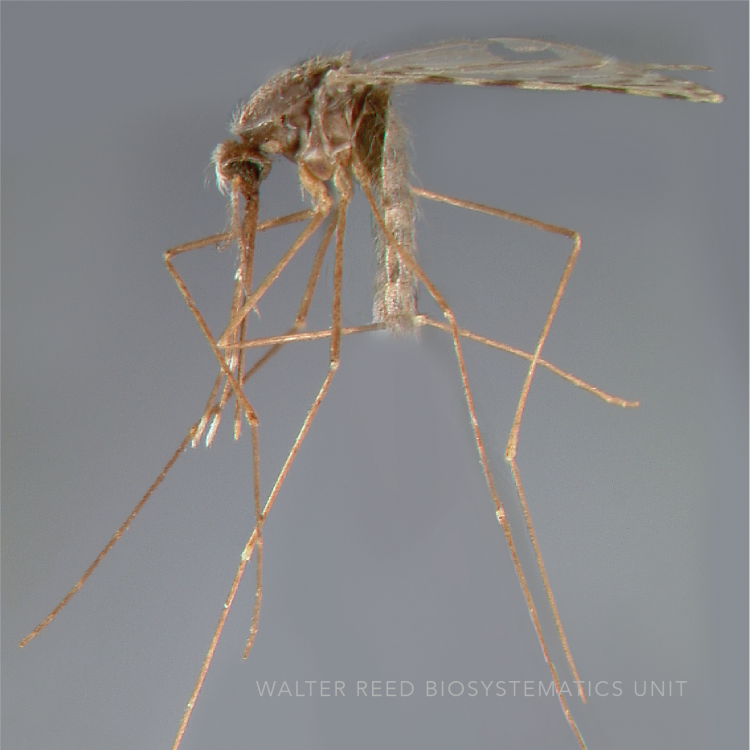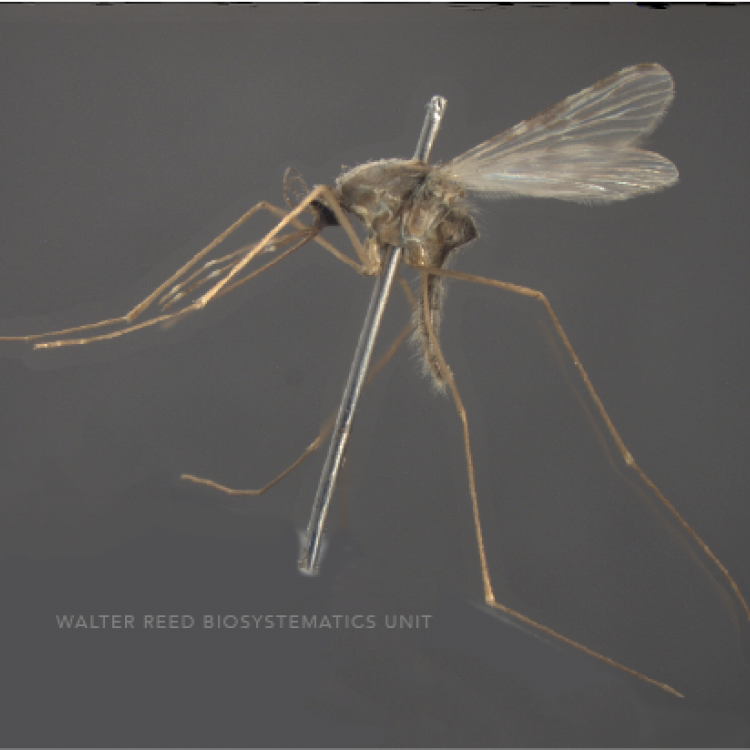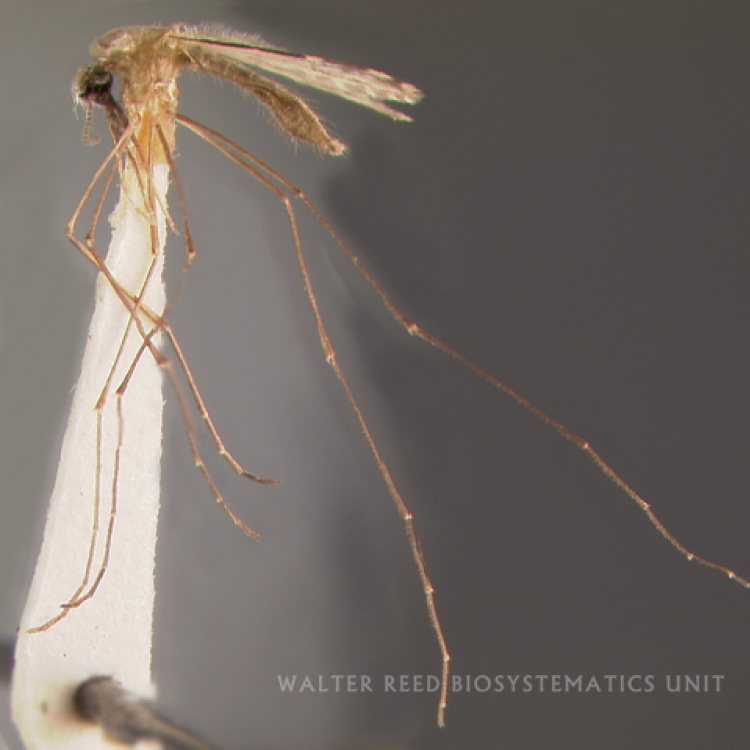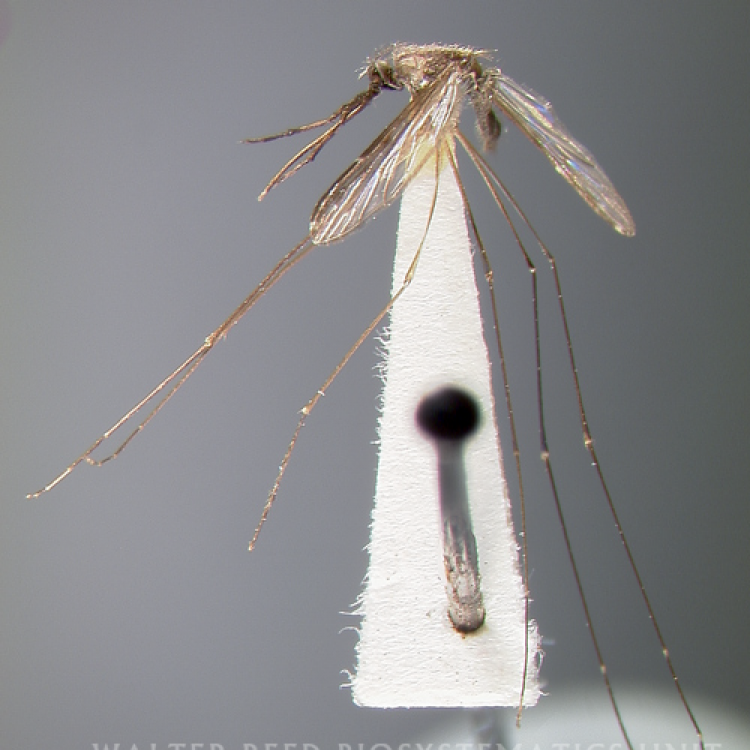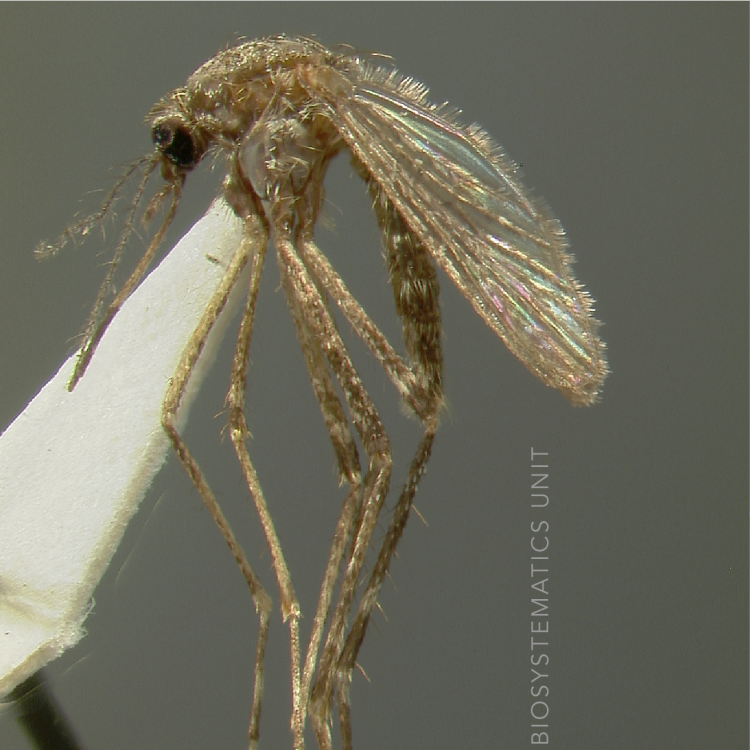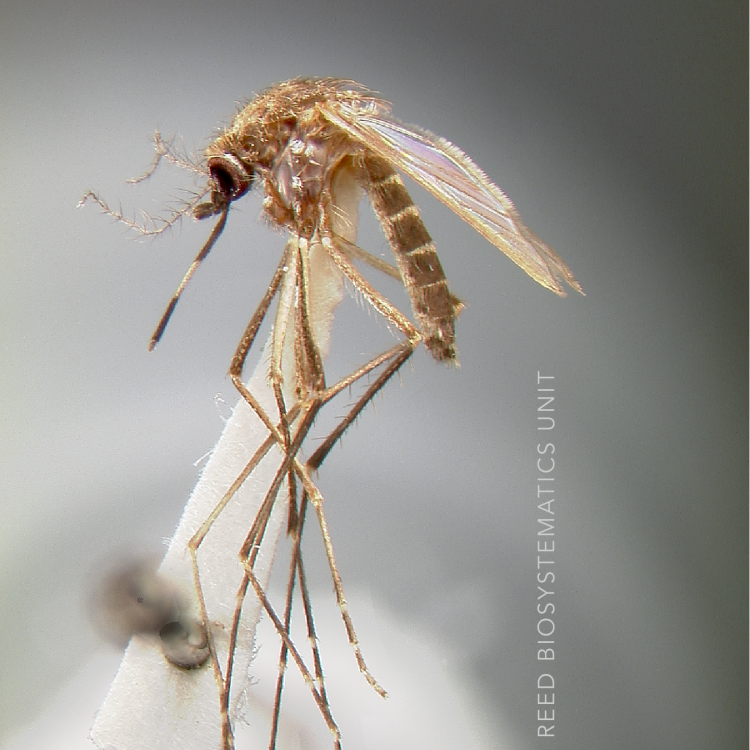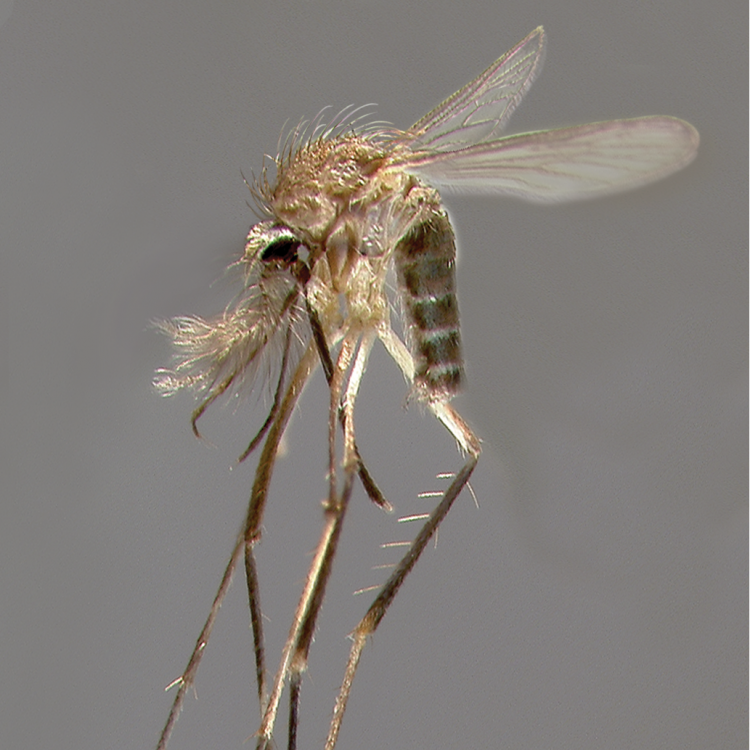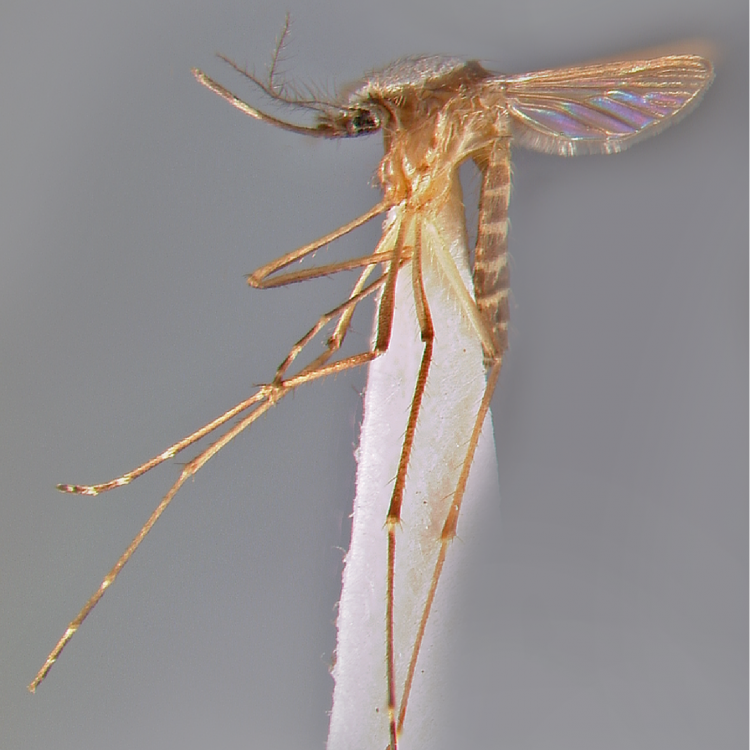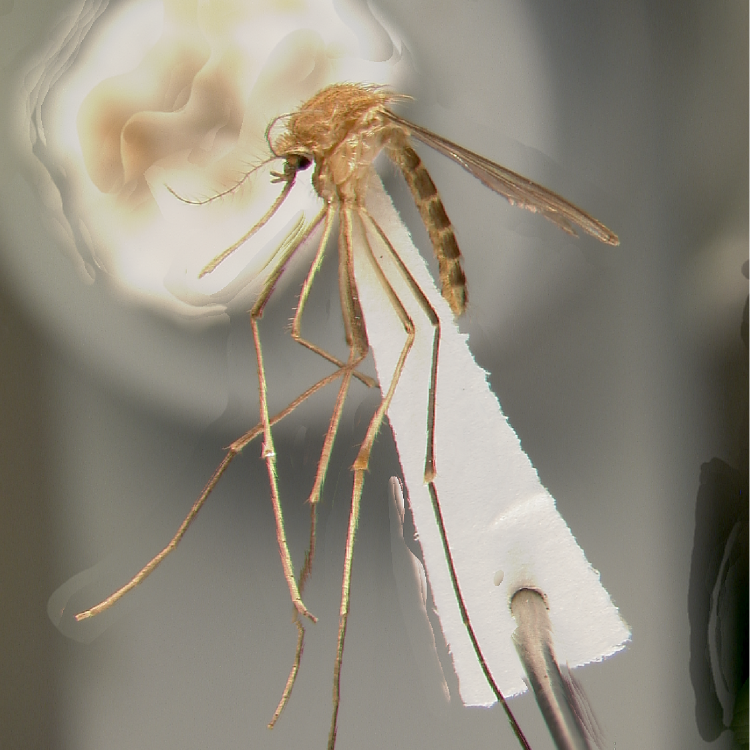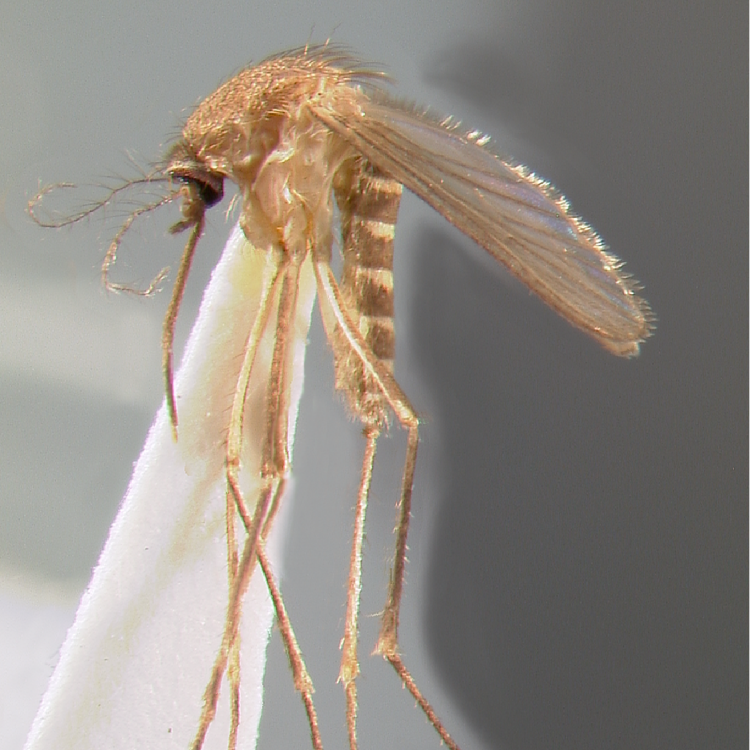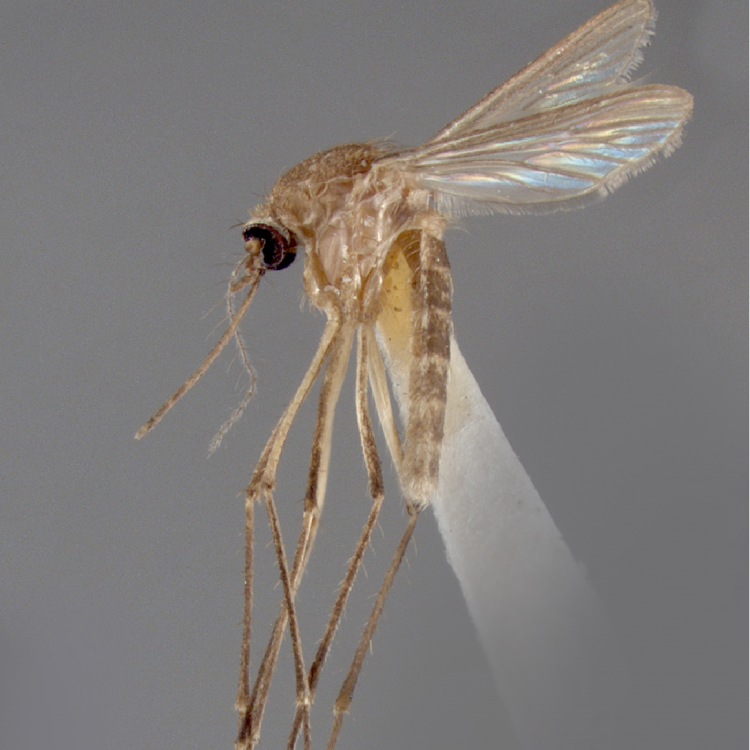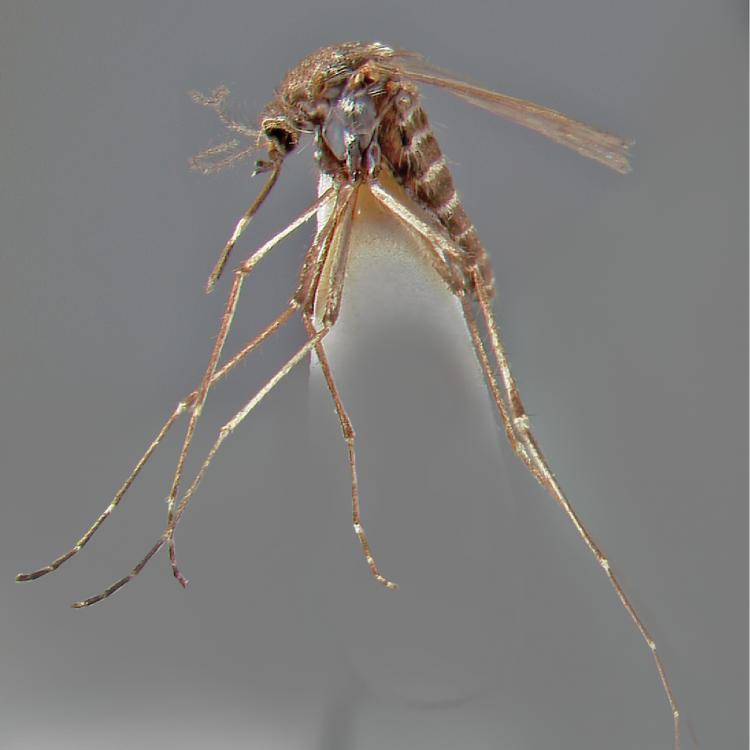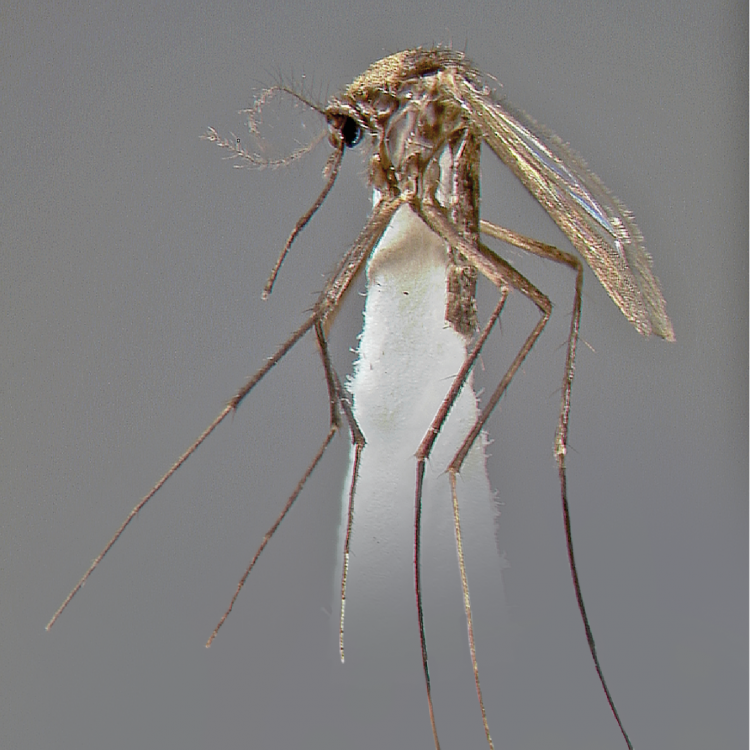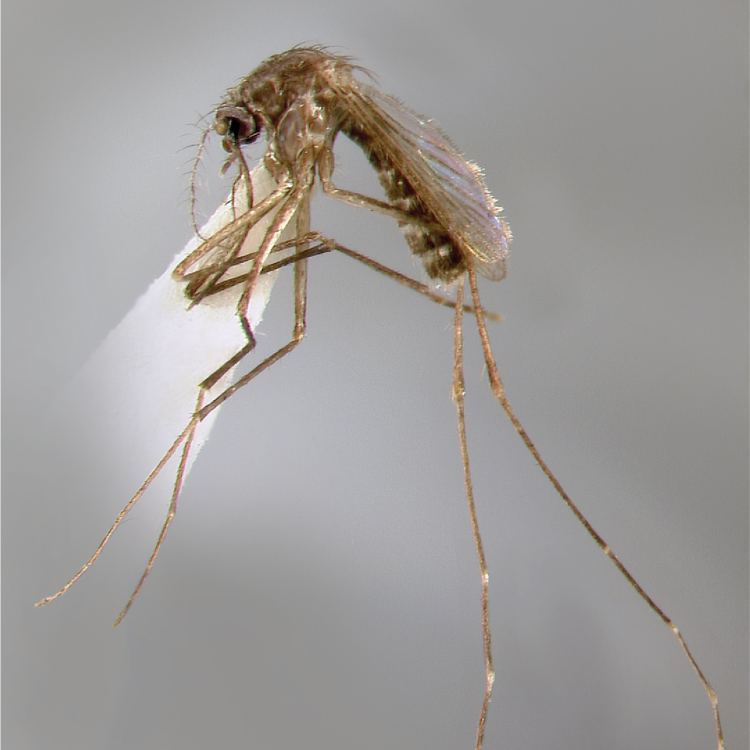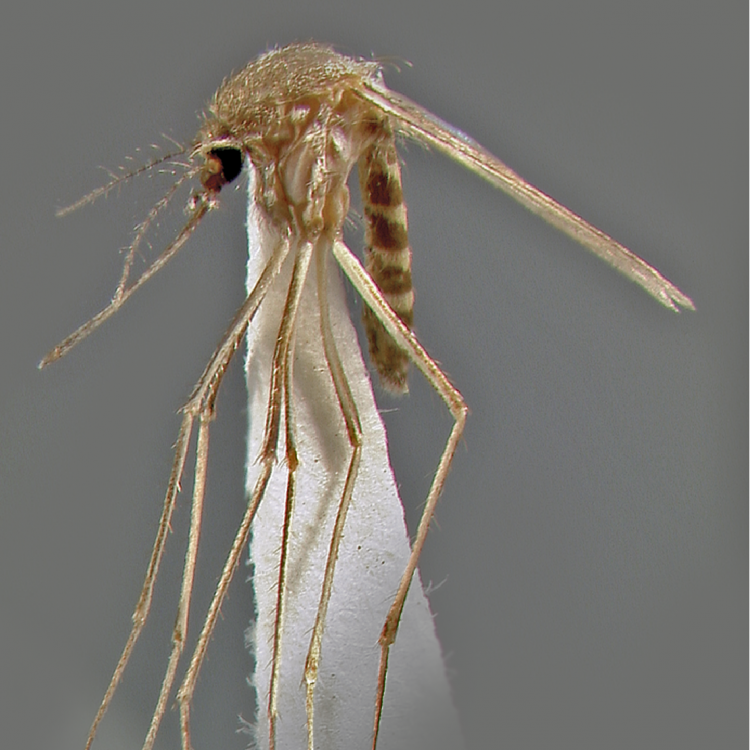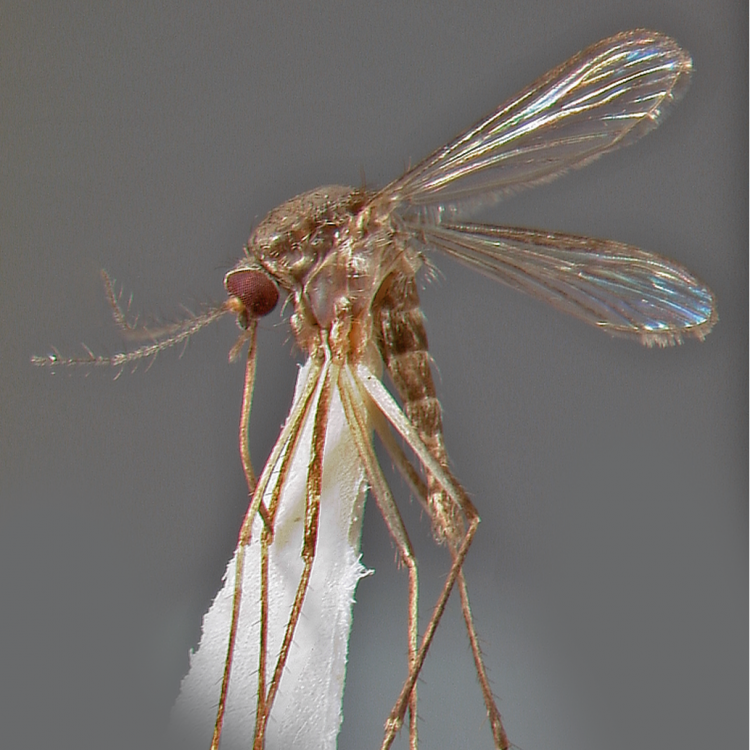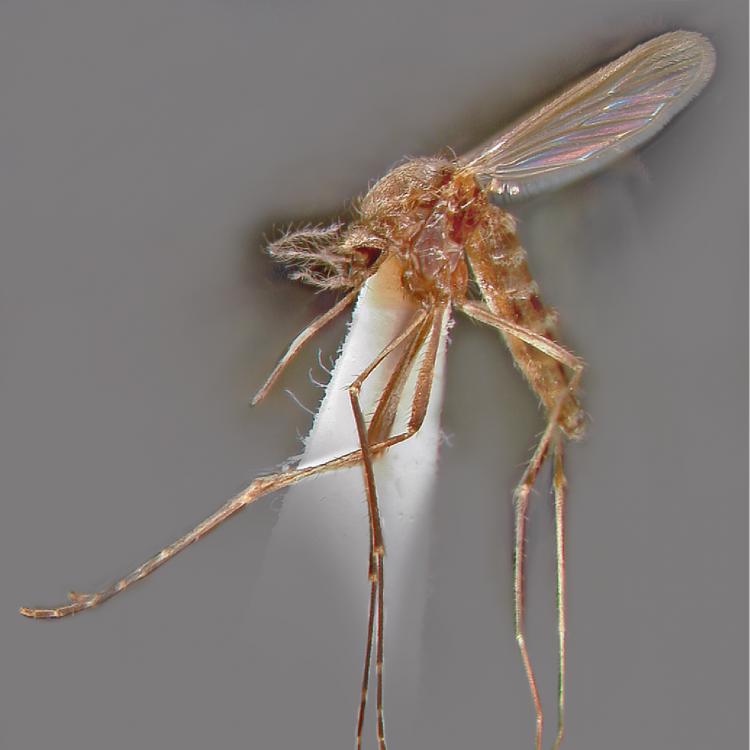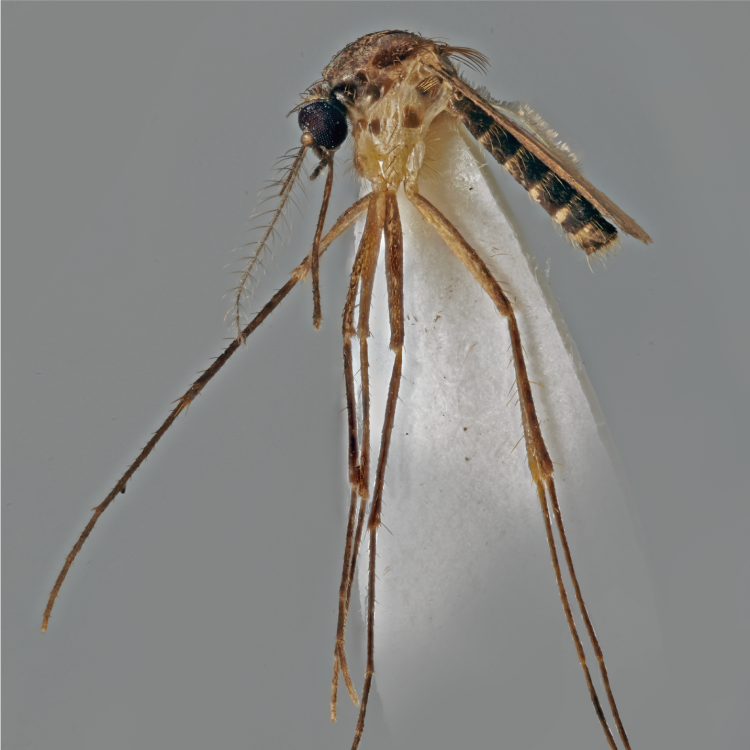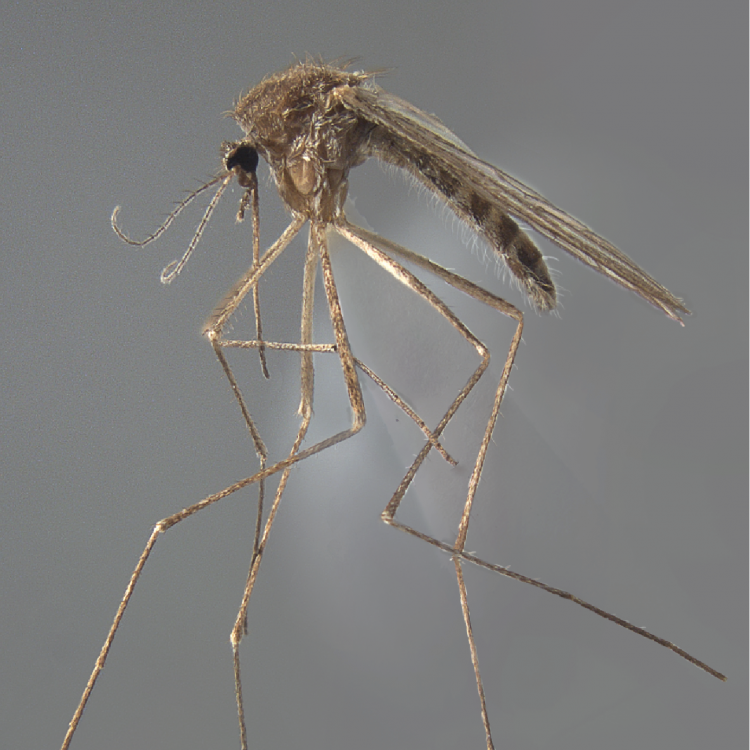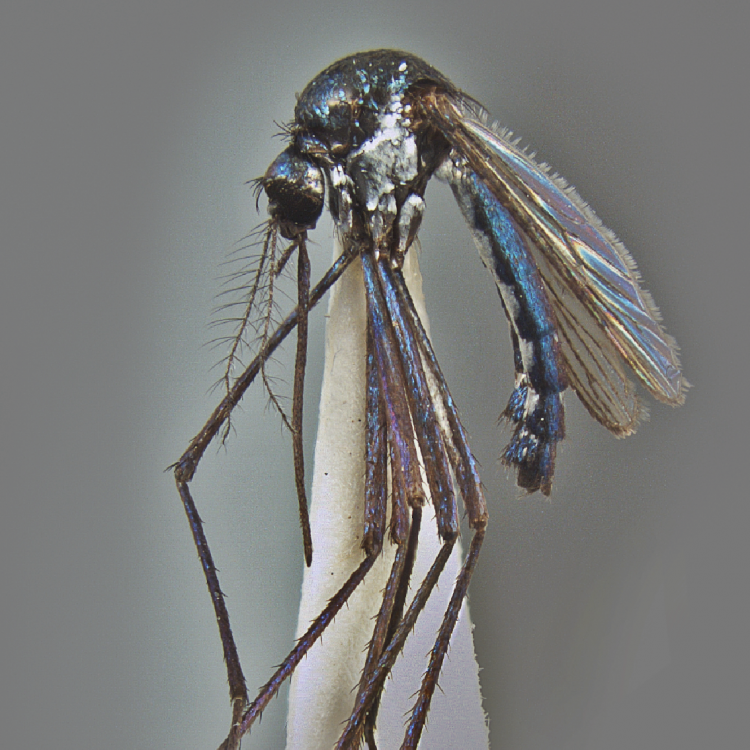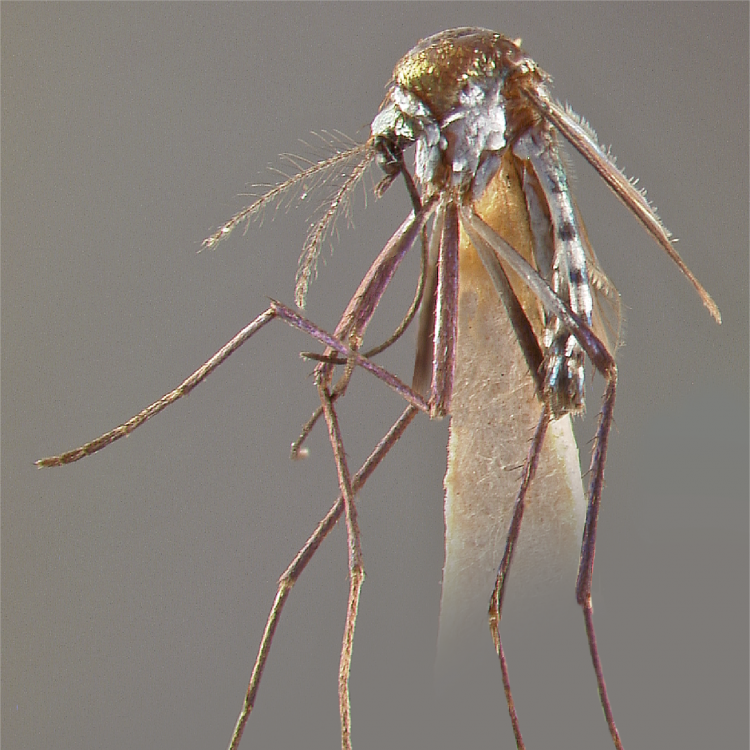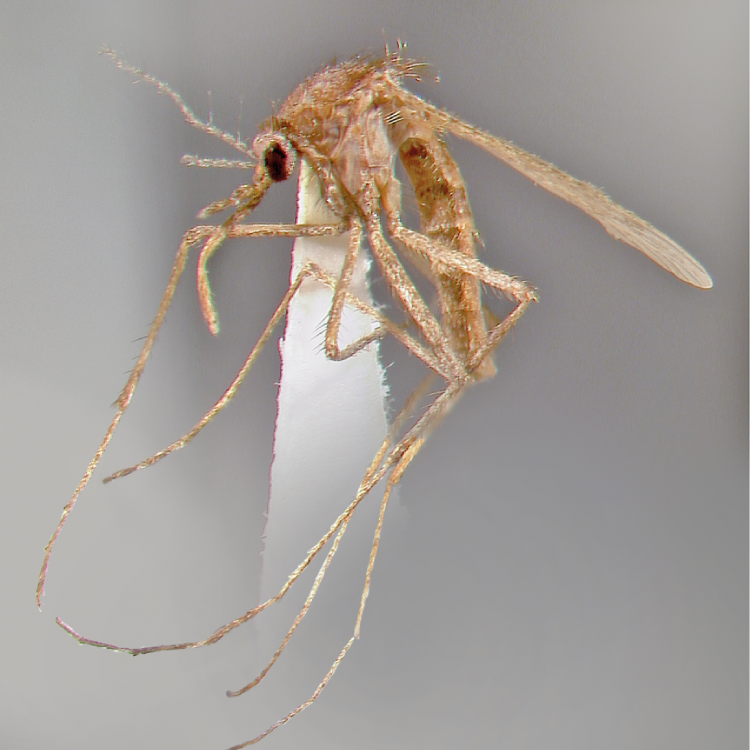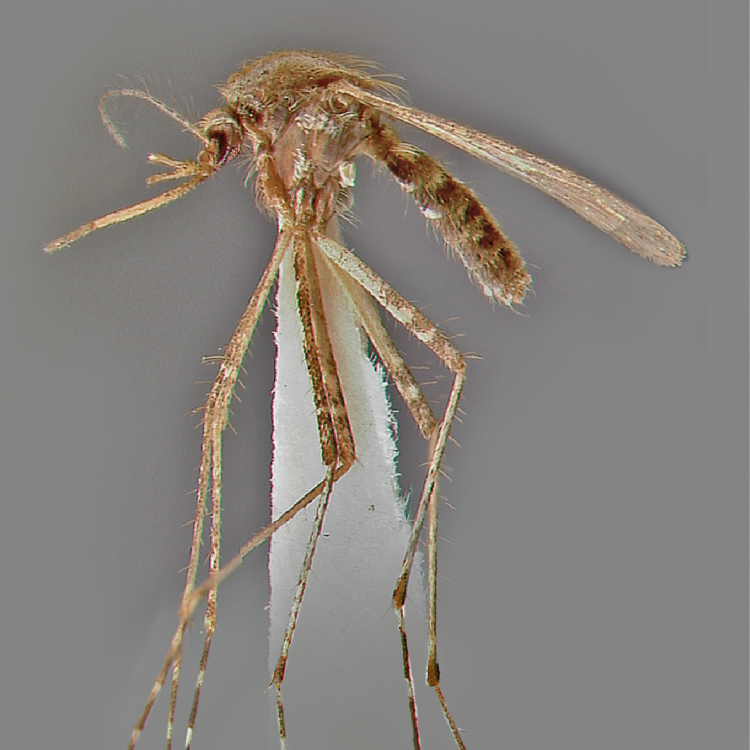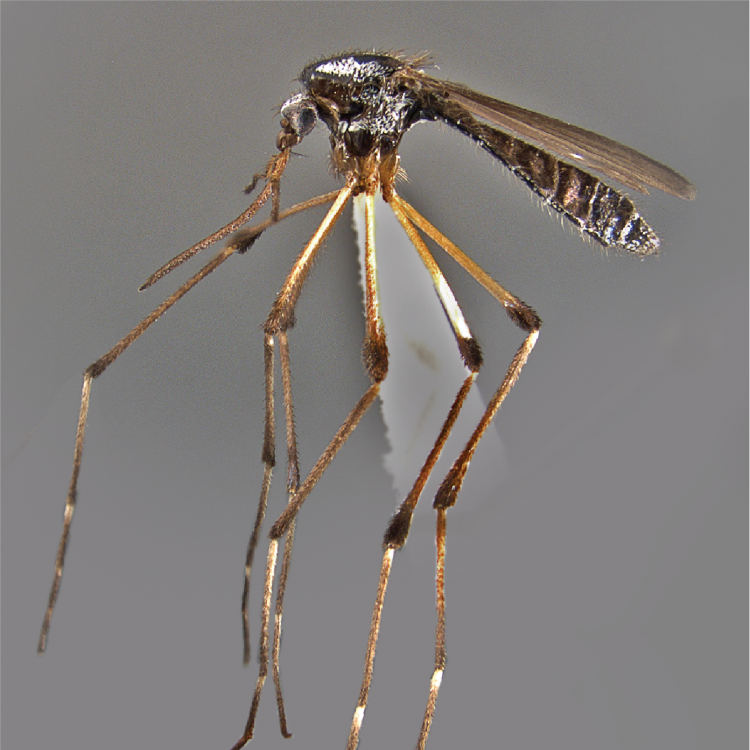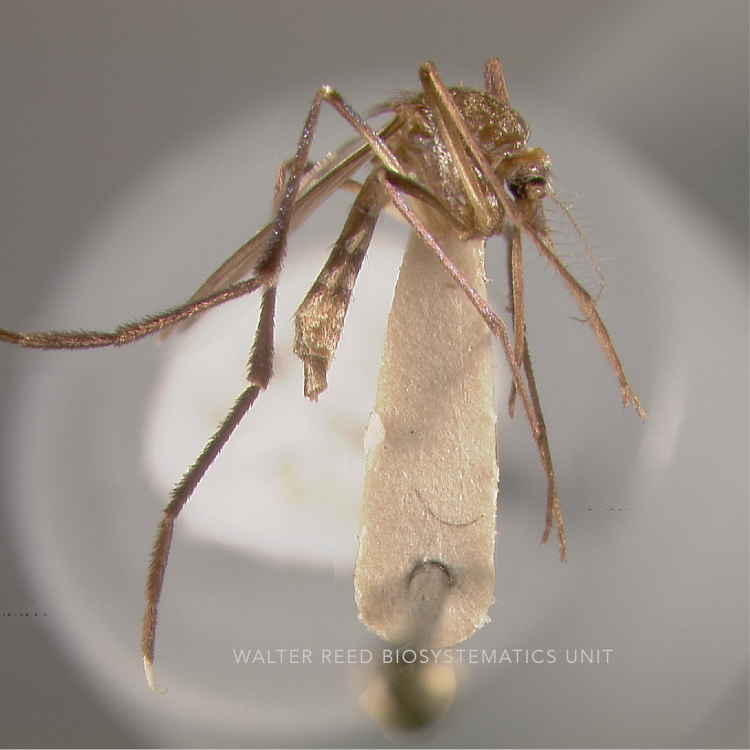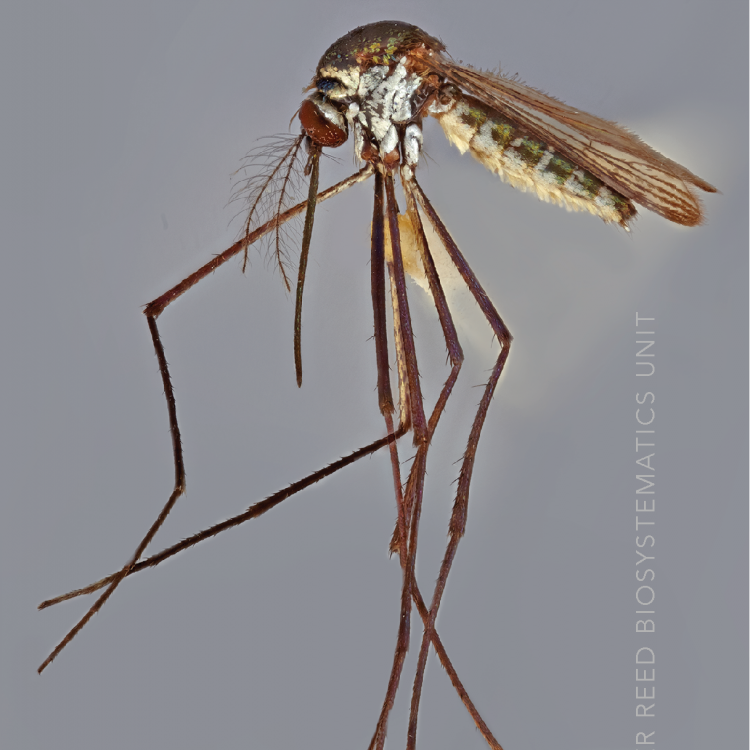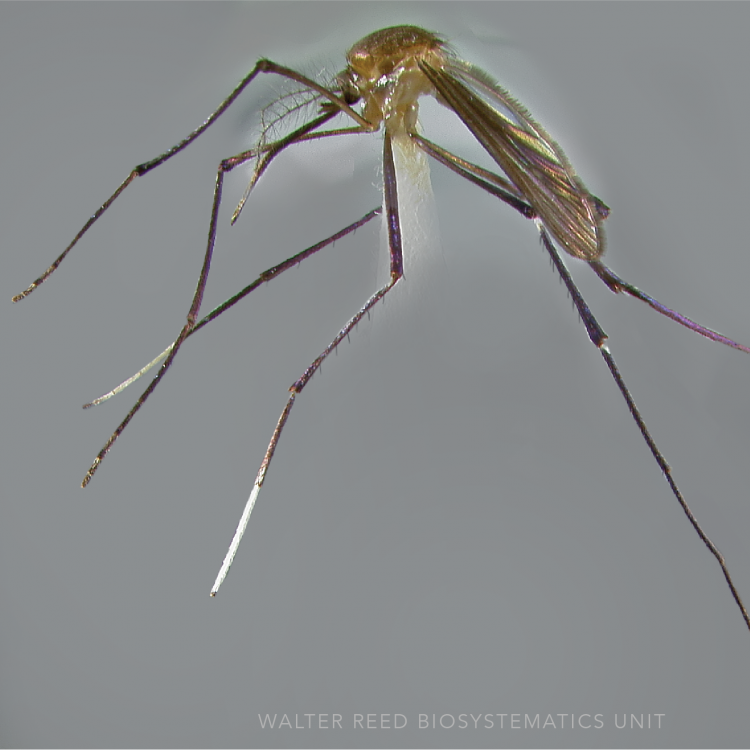AFROTROPICAL & PALEARCTIC REGIONS
Etymology: not stated [lesser, very small (L); probably refers to “small delicate mosquito”]
Culex perexiguus is one of four species in the Univittatus Subgroup, which includes Cx. fuscocephala Theobald, Cx. neavei Theobald, and Cx. univittatus Theobald. Culex perexiguus was previously synonymized under Cx. univittatus Theobald, causing some confusion on the true distributions of these two vector taxa. European records of Cx. univittatus are all now understood to comprise Cx. perexiguus, but the delineation of taxa is unclear elsewhere in the range. Given the biomedical important of the Univittatus Subgroup, it is imperative to determine the true geographical distribution of the component members.
Type locality: Sidon, Palestine [Lebanon]
Type depository: Natural History Museum, London, England, United Kingdom (NHMUK)
DIAGNOSTIC CHARACTERS (Click photos to view; mouse over and click large photo to zoom in.)
ADULT (illustrated): Head: Proboscis all dark. Thorax: Postspiracular and prealar scales present; lower mesokatepisternal scales distinctly separate from upper scale patch; lower mesepimeron with at least one seta. Wing: Costa with a few pale scales at base; vein 2A present, bare or with only a few scales. Legs: Fe-II usually lacks a complete anterior pale stripe; Ti-III with broad anterior pale stripe; Ta-I–III without pale bands. Abdomen: Terga basal pale bands without median expansion.
LARVA (not illustrated): Head: Seta 1-C slender, about as thick as setae 5,6-C; seta 5-C usually 2,3-branched. Abdominal segments: Seta 1-IV,V usually with a few branches and <length of 2 abdominal segments combined; seta 6-VI usually single. Terminal segments: Comb scales evenly fringed at apex and sides; pecten with distal pecten spines with 2–5 ventral denticles arising proximally; siphon index 5.5–7.9; seta 1-S ≤ diameter of siphon; seta 1-S with 3–6 pairs of tufts, 1–3 pairs laterally.
TAXONOMIC KEYS
Harbach 1988
Becker et al. 2010
![]()
WRBU – Culex (Cux.) - Afrotropical (West Africa) - Adult
Exemplar DNA sequences
Cx. perexiguus COI: KF406802, KJ012103–09, KU380348, KU380382, KU380423, KU380445, KU380476
BIONOMICS
Immatures
Culex perexiguus larvae are typically found in a wide range of clean bodies of standing water—swamps, stream pools, and ponds—with emergent vegetation. Although mostly in freshwater, the immatures can tolerate some salinity, and immature Cx. perexiguus have occasionally been recovered from large artificial containers, including wells.
Adults
Like other zoonotic vectors, Cx. perexiguus feed on a variety of warm-blooded hosts, feeding exclusively on birds early in the year and switching to larger mammals (including domestic livestock) in summer and autumn. At high density and where access to large mammals or birds are restricted, Cx. perexiguus will feed on humans both indoors and out. Culex perexiguus was the dominant species passively collected on sticky nets suspended from balloons at high altitude over the Sahel, suggesting the species undertakes long-distance, high altitude migrations away from harsh climatic conditions. Given its role in the transmission of Rift Valley Fever virus (RVFV), this life strategy together with its biphasic feeding behavior is epidemiologically significant.
DISTRIBUTION NOTES
Afghanistan, Albania, Algeria, Bulgaria, Burkina Faso, Cape Verde, Egypt, Greece, Ghana, Iran, Iraq, Israel (and Gaza Strip & West Bank), Italy (includes Sicily), Jordan, Kenya, Lebanon, Mali, Malta, Mauritania, Morocco, Oman, Pakistan, Poland, Portugal, Romania, Saudi Arabia, Spain, Sudan & South Sudan, Syria, Tanzania, Tunisia, Turkey.
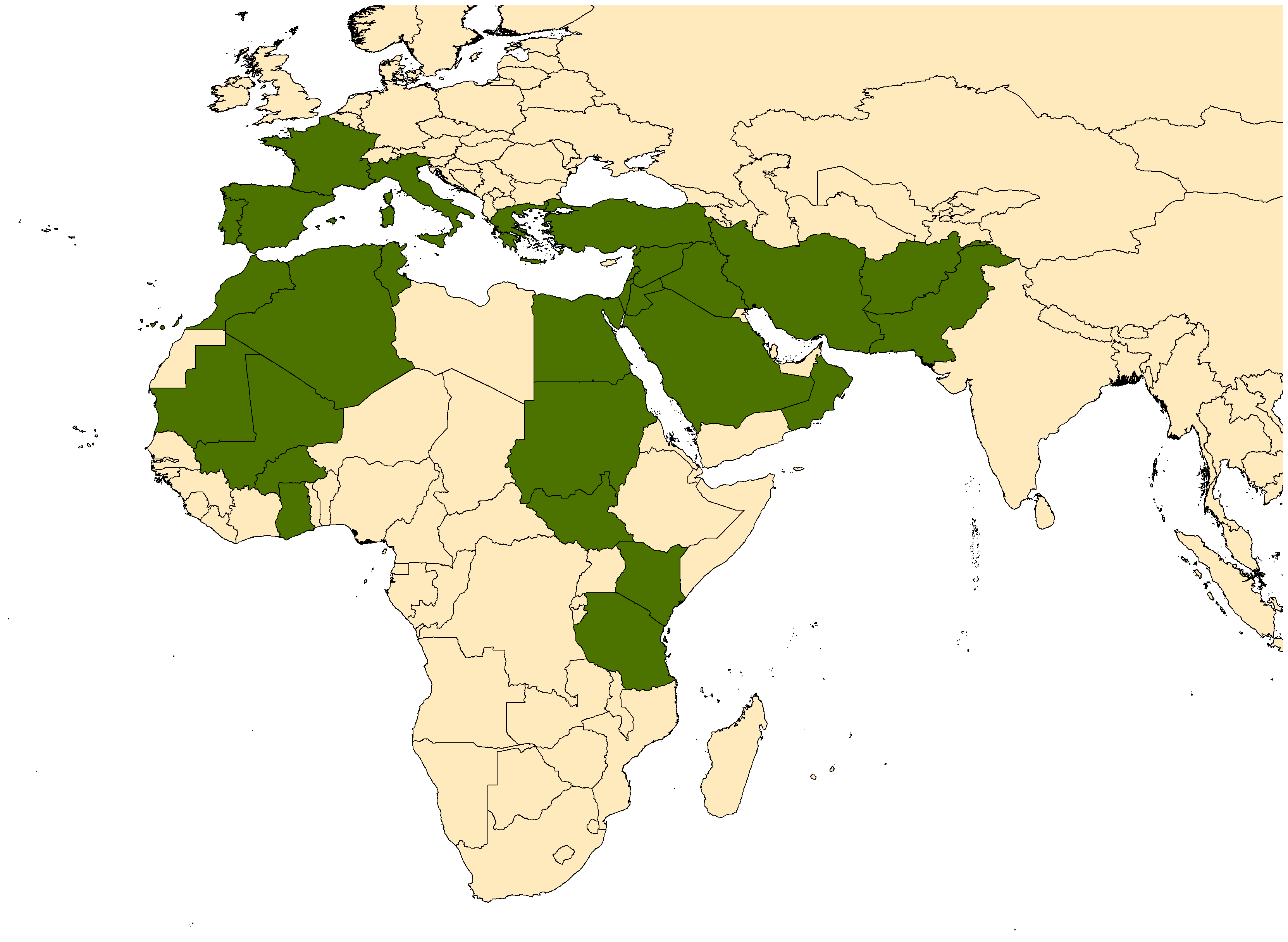
WRBU VECTOR HAZARD REPORTS
None; View other WRBU Vector Hazard Reports
Available GIS Models:
Cx_perexiguus_Dornak_1 Palaearctic
IMPORTANT REFERENCES (full citations below)
Theobald 1903a: 199 (M, F)
Séguy 1924: Pl. III (L*)
Barraud 1924m (L*)
Kirkpatrick 1925b: 125 (M*, F, P*, L*)
Mattingly & Knight 1956: 104 (to variety)
White 1975: 318 (taxonomy, distribution; from synonym with univittatus; lectotype designation)
Zaim 1987: 568 (distribution)
Harbach 1988: 57 (M*, F, P*, L*; review, taxonomy, keys, bionomics, distribution)
Jupp & Harbach 1990 (morphology, crossmating)
Amr et al. 1997 (distribution; Jordan)
Harbach 1999 (distribution; East Africa, Mediterranean subregion)
Trari et al. 2002: 331 (distribution; Morocco)
Rueda et al. 2008: 397 (distribution)
Becker et al. 2010: 273 (M*, F*, L*; keys, taxonomy, distribution, bionomics)
Alves et al. 2010 (distribution; Cape Verde)
Ahmed et al. 2011 (distribution; Saudi Arabia)
Robert et al. 2019 (distribution, Euro-Mediterranean)
CURRENT SYNONYMS
None
CITED REFERENCES
Ahmed, A.M., Shaalan, E.A., Aboul-Soud, M.A.M., Tripet, F., & Al-Khedhairy, A.A. (2011). Mosquito vectors survey in the Al-Ahsaa district of eastern Saudi Arabia. Journal of Insect Science, 11, 176.
Alves, J., Gomes, B., Rodrigues, R., Silva, J., Arez, A.P., Pinto, J., & Sousa, C.A. (2010). Mosquito fauna on the Cape Verde Islands (West Africa): an update on species distribution and a new finding. Journal of Vector Ecology, 35(2), 307–312.
Amr, Z.S., Al-Khalili, Y.H., & Arbaji, A. (1997). Larval mosquitoes collected from northern Jordan and the Jordan Valley. Journal of the American Mosquito Control Association, 13(4), 375–378.
Barraud, P. J. (1924m). A revision of the Culicine mosquitoes of India. Part XVII. Indian Journal of Medical Research (Calcutta), 12, 427–434.
Becker, N., Petrić, D., Zgomba, M., Boase, C., Madon, M., Dahl, C., & Kaiser, A. (2010). Mosquitoes and their control (Second ed.). Berlin Heidelberg: Springer-Verlag.
Harbach, R.E. (1988). Mosquitoes of the subgenus Culex in southwestern Asia and Egypt (Diptera: Culicidae). Contributions of the American Entomological Institute, 24(1), 1–240.
Harbach, R.E. (1999). The identity of Culex perexiguus Theobald versus Cx. univittatus Theobald in Southern Europe. European Mosquito Bulletin, 7, 7.
Jupp, P.G., & Harbach, R.E. (1990). Crossmating and morphological studies of Culex neivai and Culex perexiguus (Diptera: Culicidae) to elucidate their taxonomic status. Mosquito Systematics, 22(1), 1–10.
Kirkpatrick, T.W. (1925b). The mosquitoes of Egypt. Egyptian Govt Anti-Malaria Commission.
Mattingly, P.F., & Knight, K.L. (1956). The mosquitoes of Arabia. I Bull Brit Mus, 89–141.
Robert, V., Günay, F., Le Goff, G., Boussès, P., Sulesco, T., Khalin, A., Medlock, J.M., Kampen, H., Petrić, D. & F. Schaffner. (2019). Distribution chart for Euro-Mediterranean mosquitoes (Western Palaearctic region). Journal of the European Mosquito Control Association, 37, 1–28.
Rueda, L.M., J.E. Pecor, J., Lowen., R. G., & Carder, M. (2008). New record and updated checklist of the mosquitoes of Afghanistan and Iraq. Journal of Vector Ecology, 3(2), 397–402.
Séguy, E. (1924). Les moustiques de l'Afrique Mineure, de l'Egypte et de la Syrie. Encyclopedie Entomologique (A), 1, 1–257.
Theobald, F.V. (1903a). A monograph of the Culicidae of the World (Vol. 3). London: British Museum (Natural History). 359pp.
Trari, B., Dakki, M., Himmi, O., & El Agbani, M.A. (2002). Le moustiques (Diptera: Culicidae) du Maroc: Revue bibliographique (1916–2001) et inventaire des espèces. Bulletin de la Société de pathologie exotique (Paris), 96(4), 329–334.
White, G.B. (1975). Notes on a catalogue of the Ethiopian Region. Mosquito Systematics, 7(4), 303–344.
Zaim, M. (1987). The distribution and larval habitat characteristics of Iranian Culicinae. Journal of the American Mosquito Control Association, 3(4), 568–573.
CITE THIS PAGE
Walter Reed Biosystematics Unit (Year). Culex perexiguus species page. Walter Reed Biosystematics Unit Website, http://wrbu.si.edu/vectorspecies/mosquitoes/perexiguus, accessed on [date (e.g. 03 February 2020) when you last viewed the site].


